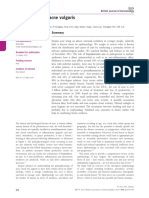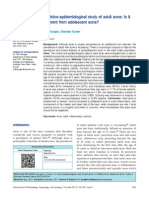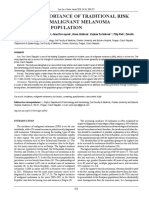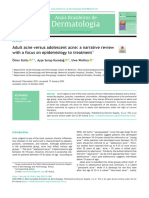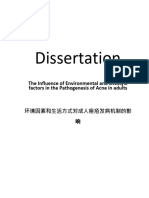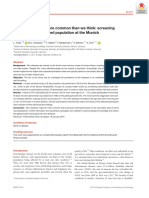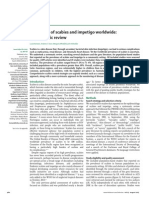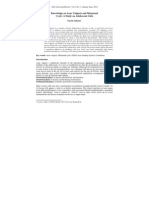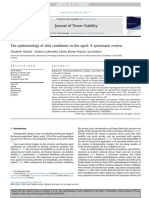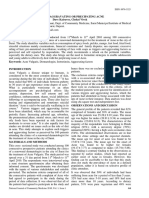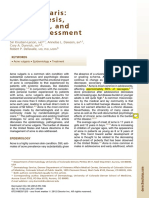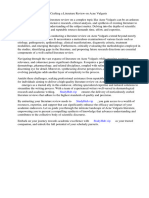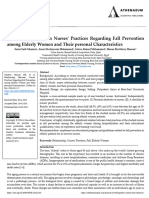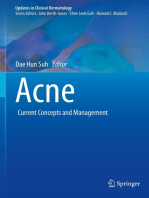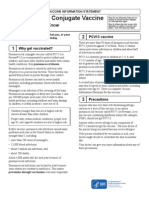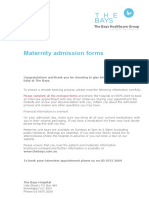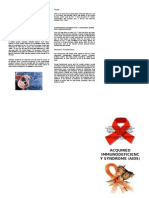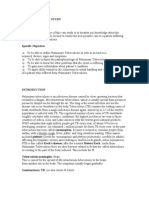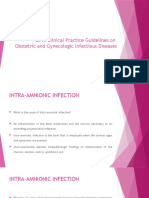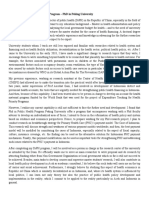Systematic Review of The Epidemiology of Acne Vulgaris: Anna Hwee Sing Heng & Fook Tim Chew
Systematic Review of The Epidemiology of Acne Vulgaris: Anna Hwee Sing Heng & Fook Tim Chew
Uploaded by
Rita MantovanCopyright:
Available Formats
Systematic Review of The Epidemiology of Acne Vulgaris: Anna Hwee Sing Heng & Fook Tim Chew
Systematic Review of The Epidemiology of Acne Vulgaris: Anna Hwee Sing Heng & Fook Tim Chew
Uploaded by
Rita MantovanOriginal Title
Copyright
Available Formats
Share this document
Did you find this document useful?
Is this content inappropriate?
Copyright:
Available Formats
Systematic Review of The Epidemiology of Acne Vulgaris: Anna Hwee Sing Heng & Fook Tim Chew
Systematic Review of The Epidemiology of Acne Vulgaris: Anna Hwee Sing Heng & Fook Tim Chew
Uploaded by
Rita MantovanCopyright:
Available Formats
www.nature.
com/scientificreports
OPEN Systematic review of the
epidemiology of acne vulgaris
*
Anna Hwee Sing Heng & Fook Tim Chew
A systematic review was conducted on epidemiology studies on acne obtained from a Web of Science
search to study risk factors associated with acne presentation and severity. A strong association was
observed between several risk factors – family history, age, BMI and skin type – and acne presentation
or severity in multiple studies. The pooled odds ratio of 2.36 (95% CI 1.97–2.83) for overweight/obese
BMI with reference to normal/underweight BMI and the pooled odds ratio of 2.91 (95% CI 2.58–3.28)
for family history in parents with reference to no family history in parents demonstrate this strong
association. In addition, a pooled odds ratio of 1.07 (95% CI 0.42–2.71) was obtained for sex (males
with reference to females). However, the association between other factors, such as dietary factors and
smoking, and acne presentation or severity was less clear, with inconsistent results between studies.
Thus, further research is required to understand how these factors may influence the development
and severity of acne. This study summarizes the potential factors that may affect the risk of acne
presentation or severe acne and can help researchers and clinicians to understand the epidemiology
of acne and severe acne. Furthermore, the findings can direct future acne research, with the hope of
gaining insight into the pathophysiology of acne so as to develop effective acne treatments.
Acne Epidemiology
The Global Burden of Disease Study 2010 found that acne vulgaris (henceforth acne) is the eight most common
skin disease, with an estimated global prevalence (for all ages) of 9.38%1. In different countries and among dif-
ferent age groups, the prevalence of acne varies, with estimates ranging from 35% to close to 100% of adolescents
having acne at some point2.
Symptoms and Impacts of Acne
Acne patients typically present with comedones, papules and pustules3. Comedones can be subdivided into two
types – open comedones (blackheads), which are clogged follicles with openings exposing its contents to the air,
and closed comedones (white heads), which are clogged follicles without an opening4. Papules are raised lesions
on the skin that are smaller than 1 cm in diameter while pustules are similar to papules but inflamed and filled
with pus4. In patients with severe acne, nodules and cysts – inflamed, swollen lesions that are at least 5 mm large
– may be present3,4. In addition, other symptoms such as the scars, erythema and hyperpigmentation may be
observed in acne patients4.
On top of discomfort due to the clinical symptoms of acne, patients may experience other negative impacts. A
study observed significantly higher unemployment rates among acne cases relative to controls, suggesting a corre-
lation between acne and employment5. Further, acne has been found to adversely affect the social life6, self-esteem
and body image of individuals and is often co-morbid with psychological disorders including depression and
anxiety3. Additionally, acne is associated with substantial financial costs, with one study estimating that the cost
of treating acne in Germany adds up to 400 million Euros annually7.
Aim
This review aims to analyze the epidemiology of acne around the world and investigate the factors that signifi-
cantly modify the risk of presenting the condition.
Department of Biological Sciences, National University of Singapore, Singapore, Singapore. *email: dbscft@nus.
edu.sg
Scientific Reports | (2020) 10:5754 | https://doi.org/10.1038/s41598-020-62715-3 1
www.nature.com/scientificreports/ www.nature.com/scientificreports
Results and Discussion
Epidemiology of acne. The 35 articles reviewed differed in study design, acne definition and severity grad-
ing systems, variables studied and population characteristics. Population characteristics such as age and sex dif-
fered between studies depending on the type of acne and variables the researchers were interested in. For instance,
Wei et al.8 studied adolescent acne, Kaminsky, Florez-White, Bagatin and Arias9 studied adult acne, and Park,
Kwon, Min, Yoon and Suh10 studied childhood acne. Similarly, some studies only studied the risk factors for acne
in females11 while others only studied acne in males12. Sample sizes used also varied, ranging from 88 in Ismail,
Manaf & Azizan13 to 27,083 in Klaz, Kochba, Shohat, Zarka & Brenner14. Further, some studies investigated the
co-morbidities of acne, however, since this paper is not intended to provide a review of acne co-morbidities, they
will not be discussed here.
The acne and severity grading systems used by the different studies is described in Table 1. Depending on the
acne definition and severity grading system used, the resulting prevalence estimates differ. Despite the presence
of objective symptoms of acne (such as the presentation of comedones, papules and/or pustules), dermatologists
disagree about the minimal criteria that should be used to diagnose the condition15. Similarly, efforts to create a
standardized grading system for acne severity have been unsuccessful and over 25 different systems are currently
in use16. As such, different studies use different definitions and grading criteria, making it difficult to compare
their results and derived prevalence estimates3,16. The prevalence estimates obtained are also influenced by other
factors such as the sample size and country studied. A larger sample will result in a more representative preva-
lence estimate. Prevalence estimates ranged from 26.8% in a study conducted in Germany17 to 96% in a study
conducted in Brazil18. A summary and description of the articles reviewed can be found in Table 1.
Demographic factors that influence acne presentation. Many papers have demonstrated that acne
presentation is influenced by demographic factors. The onset of acne typically correlates with the onset of puberty,
when sebum production increases19. As such, the prevalence of acne increases with increasing age, showing high-
est incidence in teenagers and a relatively low incidence in pre-pubertal children19. After reaching the late teenage
years or young adulthood, acne prevalence rates follow a decreasing trend with increasing age19,20. The results
of the reviewed articles generally followed this trend, with higher odds of acne in teenagers compared to young
adults and children (Tables 2, 3).
Previous reviews have reported that the prevalence of acne is higher in females than males20,21. Similarly, the
Global Burden of Disease Study conducted in 2010 estimated that the prevalence of acne was 8.96% in males,
lower than the estimated prevalence of 9.81% in females1. Lynn et al.21 also noted higher acne prevalence in
females at younger ages, possibly due to the earlier onset of puberty in females relative to males. However, the
papers reviewed in this study showed mixed results, with only two papers revealing a higher odds of acne in
females while another three demonstrated a higher odds of acne in males (Table 3). These results may be due to
differences in the characteristics of the sampled population or country studied. Notably, in a study that found
lower odds of acne in females than males, the odds ratio was adjusted for stage of puberty, removing the potential
confounders of age and onset of puberty22. When the pooled odds ratio was calculated, an OR of 1.07 (95% CI
0.42–2.71; males with reference to females) was obtained (Fig. 1) suggesting that male sex is only associated with
a slight increase in acne risk.
Relatively few studies considered other demographic factors. Factors including years of education, socioec-
onomic status and parent’s educational level did not significantly affect acne prevalence. Studies also found that
low computer usage and marriage were protective for acne while working in an office was a risk factor for acne.
Demographic factors that influence acne severity. Demographic factors also influence the sever-
ity of acne. The articles reviewed revealed that the odds of severe acne are higher in older teenagers compared
to younger teenagers or preteens (Table 4). As sebum production increases during puberty, older teenagers
tend to have higher sebum production compared to younger teenagers. High sebum levels favor the growth of
Propionibacterium acnes, a species of bacterium implicated in inflammatory processes in acne and the develop-
ment of inflammatory acne lesions which are typically associated with more severe acne18,19.
Previous reviews have found that severe acne is more common in males compared to females21. Most of the
articles reviewed in this study are in line with this trend, demonstrating an association between severe acne and
being male (Tables 4, 5). One study reported higher severe acne prevalence in females relative to males, for the
age group 11 to 13 but not the 14 to 15 or 16 to 17 age groups23, which may be, at least in part, due to the earlier
onset of acne in females2.
Other demographic factors were rarely investigated. In contrast to the results found for acne prevalence, par-
ent’s education level and family education level were found to increase the risk of more severe acne. Further, a
study reported a higher risk of severe acne in Whites at age 14 to 15 and those who were the only child at age 16
to 17 while household income was not significantly correlated with acne severity23.
Genetic and hormonal factors that influence acne presentation. Studies have also demonstrated
the impact of genetic factors on acne presentation. Dreno and Poli24 reported that a positive family history of acne
in parents was associated with increased acne risk in their offspring. While the articles reviewed in this study used
different definitions of family history, with some considering only parents and others including siblings, first- or
second-degree relatives, regardless of the definition used, the large majority of the articles consistently found that
a positive family history was significantly associated with increased odds of acne in individuals. The pooled odds
ratio of 2.91 (95% CI 2.58–3.28; family history in parents with reference to no family history in parents) suggests
that family history in parents is associated with an increased risk of acne presentation (Fig. 2). Two case-control
studies were excluded from the meta-analysis due to study design, but their results were still in line with the
observed trend in the meta-analysis11,25. In addition, a study seems to suggest a possible additive effect of maternal
Scientific Reports | (2020) 10:5754 | https://doi.org/10.1038/s41598-020-62715-3 2
www.nature.com/scientificreports/ www.nature.com/scientificreports
Definition of Parameters that differ Parameters that differ between Severity Acne grading
Country Sample (size, age) Study design Prevalence acne between control and case groups of different acne severity grading system system Ref, date
Cross-sectional design
Significant risk factors:
60.7% of age, BMI, diet (fat, sugar
the 2230 intake, frequent intake of
participants fast food, desserts) Significant risk factors associated
Cross-
(after exclusion Clinical Significant protective with increased acne severity: Pillsbury’s
Turkey, 2300 individuals sectional, Presence of any
of participants diagnosis by factors: diet (fruit acne duration, age, BMI, living diagnostic Aksu, et al., 2012
Eskisehir aged 13–18 years self-report acne lesion
who did not dermatologists and vegetable intake) environment, sex, skin type (oily) criteria
questionnaire
answer at frequency of face washing Insignificant factors: family history
least 90% of per day (with tap water),
questionnaire) living environment
Insignificant factors: sex
Significant protective
65% in teenagers
Cross- factors: age, diet
and 28% in
Pakistan, 1000 teenagers and sectional, Self-reported (non-spicy food intake) Self-reported
adults (overall N/A N/A Ali, et al.50
Quetta young people interview using acne premenstrual stage, acne
prevalence not
a questionnaire marital status, sex, skin
reported)
type (dry, normal, oily)
Significant risk factors:
BMI, diet (carbonated
Significant risk factors associated
drink, fat, white bread,
with increased acne severity: BMI,
sweets intake), family
diet (fat, sweets intake)
history (parents), smoking Numbers
Clinical Significant risk factors associated
Cross- status and types of
148 high school diagnosis with decreased acne severity: diet
Romania, sectional, 47.3% of high Significant protective inflammatory Presence of any Al Hussein, et al.,
students aged of acne (fruits/vegetables intake)
Tîrgu Mureș self-report school students factors: diet (fish, fruits/ and non- acne lesion 2016
16–20 years vulgaris by a Insignificant factors: diet (general,
questionnaire vegetables intake) inflammatory
dermatologist carbonated drink, dairy, fish, white
Insignificant factors: diet acne lesions
bread intake), family history, lack
(dairy intake), irregular
of nutritional information, living
meals, lack of nutritional
environment, smoking status
information, living
environment
Significant risk factors associated
with increased acne severity: age, Numbers
Insignificant factors:
Cross- Clinical family history (siblings), parent’s and types of
family history (parents
Brazil, São 452 students aged sectional, diagnosis by 3 education level inflammatory Presence of any Bagatin, et al.,
96% of students and relatives), parent’s
Paulo 10 to 17 years self-report independent Insignificant factors: family history and non- acne lesion 2014
educational level, skin
questionnaire evaluators (first-degree relatives excluding inflammatory
colour
siblings), race, sex, skin colour, acne lesions
smoking status
Significant risk factors for
inflammatory lesions only: height
(tall), skin colour (light)
Insignificant factors for
inflammatory lesions only: BMI,
diet (cheese, chocolate, low fat milk,
whole milk and yoghurt intake),
smoking status, years of education
Significant risk factors for
Significant protective noninflammatory acne only: height
factors: height (short), skin (tall), skin type (dark), Numbers
Cross- colour (light) Insignificant factors for and types of
Clinical
Brazil, 2,201 males aged sectional, Insignificant factors: BMI, noninflammatory acne only: BMI, inflammatory Presence of any
89.1% of males diagnosis by a Duquia, et al., 2017
Pelotas 18 years self-report diet (cheese, chocolate, diet (cheese, chocolate, low fat milk, and non- acne lesion
dermatologist
questionnaire low fat milk, whole milk, whole milk and yoghurt intake), inflammatory
yoghurt intake), smoking smoking status, years of education, acne lesions
status, years of education Significant risk factors for both
inflammatory and noninflammatory
acne: diet (yoghurt intake), height
(tall), skin colour (light)
Insignificant factors for
both inflammatory and
noninflammatory acne: BMI, diet
(cheese, chocolate, low fat milk and
whole milk intake), smoking status,
years of education
Significant risk factors associated
with increased acne severity: age,
diet (chocolates/sweets, nuts,
oily food intake), family history
(parents and siblings), mental stress,
number of family members with
Clinical acne history, personal evaluation of
Cross- Global Alliance Global Alliance
diagnosis by skin oiliness, premenstrual phase,
1002 students aged sectional, 93.2% of the to Improve to Improve Ghodsi, Orawa, &
Iran, Tehran dermatologists N/A skin type
12–20 years self-report students Outcomes in Outcomes in Zouboulis51
and general Insignificant factors: age of
questionnaire Acne Acne
practitioners menarche, diet (spicy food intake),
fasting, frequency of face washing
per day, physical exercise, regularity
of menses, seasons of the year, sex,
sleep duration, smoking status, sun
exposure, travel to humid regions,
use of cosmetics, winter skin
Continued
Scientific Reports | (2020) 10:5754 | https://doi.org/10.1038/s41598-020-62715-3 3
www.nature.com/scientificreports/ www.nature.com/scientificreports
Definition of Parameters that differ Parameters that differ between Severity Acne grading
Country Sample (size, age) Study design Prevalence acne between control and case groups of different acne severity grading system system Ref, date
Physical
Cross- examination,
Ghana, Clinical Significant risk factors:
1394 children aged sectional, presence of at Hogewoning, et
Greater N/A diagnosis by age, BMI, living N/A N/A
9 to 16 physical least six facial al., 2009
Accra dermatologists environment, sex
examination pustules or
papulopustules
Significant risk factors associated
with increased acne severity:
acanthosis nigricans, exposure to
chemical substances, hirsutism,
hyperseborrhea, onset of acne
during adolescence, sex
Latin
Cross- Significant risk factors associated
America Clinical Kaminsky, Florez‐
1384 acne cases sectional, with decreased acne severity: GILEA acne
and Iberian N/A diagnosis by a N/A N/A White, Bagatin, &
aged 25 to 60 self-report makeup use, clasification
Peninsula, 21 dermatologist Arias, 2019
questionnaire Insignificant factors: age at
countries
menarche, alopecia, climate, diet,
family history, onset of menopause,
sun exposure, sunbed usage,
tobacco use, use of contraceptives
(hormonal), regular use of acne
drugs
Significant risk factors: Significant risk factors associated
age, BMI, family history with decreased acne severity: BMI,
82.9% of
(parents), onset of puberty, Significant risk factors associated
Cross- the 1229 Karciauskiene,
Clinical Insignificant factors: with mild and moderate/severe Leeds revised
1277 students aged sectional, participants Presence of any Valiukeviciene,
Lithuania diagnosis by a alcohol intake, diet (dairy, acne: family history (maternal acne, acne grading
7–19 years self-report who underwent acne lesion Gollnick & Stang,
dermatologist fast food, fish, fruits/ paternal acne and acne in both system
questionnaire clinical 2014
vegetables, lemonade, parents)
diagnosis
meat, sweets intake), Insignificant factors: onset of
smoking status puberty, sex
0.88% severe
acne (prevalence Significant risk factors associated Kligman and
Cross- Clinical Klaz, Kochba,
Israel, Tel 27083 males aged of mild/ with decreased acne severity: Plewig grading
sectional, diagnosis by N/A N/A Shohat, Zarka &
Aviv 21–22 years moderate number of cigarettes smoked per and Leeds acne
interviews dermatologists Brenner, 2006
acne was not day, smoking status grading system
reported)
Significant risk factors:
Severity
age, BMI, diet (chocolates/
grading was
Cross- sweets intake)
693 elementary 36.2% of Clinical based on
South Korea, sectional, Insignificant factors: Significant risk factors associated Presence of any Park, Kwon, Min,
school students elementary diagnosis by Lehmann et al.
Seoul self-report diet (meat, pizza intake), with increased acne severity: age acne lesion Yoon, & Suh, 2015
aged 7–12 years school students dermatologists and the Leeds
questionnaire number of face washings,
Revised Acne
sex, sleep duration, use of
Grading System
moisturiser,
Cross- Grading scale Perera, Peiris,
Significant risk factors associated
Sri Lanka, 140 females aged sectional, 91.4% of Assessment by for overall Pathmanathan,
N/A with increased acne severity: use of N/A
Colombo 15–16 self report individuals interviewers severity Mallawaarachchi,
cosmetics
questionnaires (GSOS) & Karunathilake52
Significant risk factors: sex
Significant protective
factors: number of
cigarettes smoked per
Significant risk factors for mod/
day (in females), smoking
severe acne: drug usage (high usage
duration (in females),
of topical and/or systemic drugs to
smoking status (in
95.6% with treat acne), sex (male) ECLA (Echelle >20 retentional
females)
594 secondary Cross- at least one Clinical Significant protective factors d’Evaluation and/or
Belgium, Insignificant factors: Rombouts, Nijsten
school students sectional, retentional acne diagnosis by a for mod/severe acne: number Clinique des inflammatory
Antwerp age of menarche, & Lambert, 2006
aged 13 to 18 interviews lesion on the dermatologist of cigarettes smoked per day Lesions d’Acné) acne lesions on
drug usage, physical
face (in females), smoking duration scale the face
exercise, multivitamin
(in females), smoking status (in
consumption, number of
females), use of contraceptives
cigarettes smoked per day
(oral)
(in males), regularity of
menses, smoking duration
(in males), smoking status
(in males), sunbed usage
Significant risk factors:
Numbers
age, sex, smoking status, Significant risk factors associated
896 individuals Cross- and types of
Clinical number of cigarettes with increased acne severity: Schäfer, Nienhaus,
Germany, aged 1–87 years sectional, 26.8% of inflammatory Presence of any
diagnosis by smoked per day number of cigarettes smoked Vieluf, Berger, &
Hamburg (median age = 42 standardised participants and non- acne lesion
dermatologists Insignificant factors: per day Ring, 2001
years) interview inflammatory
alcohol intake, Insignificant factors: sex
acne lesions
socioeconomic status
Continued
Scientific Reports | (2020) 10:5754 | https://doi.org/10.1038/s41598-020-62715-3 4
www.nature.com/scientificreports/ www.nature.com/scientificreports
Definition of Parameters that differ Parameters that differ between Severity Acne grading
Country Sample (size, age) Study design Prevalence acne between control and case groups of different acne severity grading system system Ref, date
Significant risk factors associated
with increased acne severity: age,
educational level in the family at age
14–15, gastrointestinal conditions
(reflux, abdominal pain, nausea,
food allergy), number of children at
age 16–17, psychological disorders
(depression, anxiety, ADHD/ADD,
insomnia), race at age 14–15, sex at
age 11–13, sinopulmonary disorders
“Yes” response
(sinus infection, sore throat,
Cross- to the question
2.8% of the asthma, lung disease excluding
9417 individuals sectional, Self-reported ‘During the Silverberg &
US participants had N/A asthma, non-streptococcal N/A
aged 0–17 years self-report acne past 12 months, Silverberg, 2014
severe acne pharyngitis),
questionnaire has (child) had
Insignificant factors: duration of
severe acne?’
residence in the US, gastrointestinal
conditions (frequent diarrhoea,
intermittent constipation),
Hispanic origin, household
income, place of birth (outside
the US), psychological disorders
(phobias), race at age 11–13 and
16–17, sinupulmonary disorders
(tonsillitis, hay fever, respiratory
allergy)
Self-reported
acne status,
Cross- dermatologist
Criteria defined Tan, Tan,
1045 youths aged sectional, 88% self- diagnosis for Insignificant factors: age, family
Singapore N/A by Lehmann N/A Barkham, Yan, &
13–19 years self-report reported acne individuals history, race, sex
et al. Zhu53
questionnaire who reported
that they had
acne
Significant risk factors:
anxiety, depression, diet
(fried food, high fat food
and spicy food intake),
dysmenorrhoea, family
history (first- and second-
degree relatives), insomnia
Cross- (frequent), lack of sleep
5,696 Clinical Pillsbury’s
China, sectional, 51.3% of (<8 h/day), mental stress, Presence of any
undergraduates diagnosis by a N/A diagnostic Wei, et al., 2010
Shenyang self-report undergraduates menstrual disorder, sex, acne lesion
aged 17 to 25 years dermatologist criteria
questionnaire skin type (oily, mixed),
study pressure
Significant protective
factors: computer usage
(<2 h/day), diet (frequent
fruit intake), skin type
(dry, neutral)
Insignificant factors: age
Presence of
Significant risk factors:
and types of
cannabis use, diet
inflammatory
(chocolates/sweets intake)
Cross- and non-
60.7% of the Significant protective
2266 individuals sectional study, Self-reported inflammatory Wolkenstein, et
France surveyed factors: tobacco use N/A N/A
aged 15–24 years self-report acne acne lesions al., 2015
population Insignificant factors:
questionnaire present
alcohol intake, BMI, diet
determined via
(carbonated drink, dairy,
questionnaire
fast food intake)
responses
Significant risk factors:
country of residence
(Czech Republic, Slovak
57.8% of Republic), diet (chocolate
Europe, 7
individuals intake), family history
countries
(adjusted); (parents)
(Belgium,
Cross- Lowest Significant protective
Czech
sectional, prevalence rate factors: age, country of
Republic, 10,521 individuals Self-reported Wolkenstein, et
online was 42.2% in residence (Belgium and N/A N/A Self-report
Slovak aged 15–24 years acne al., 2018
self-report Poland while the Poland), tobacco use
Republic,
questionnaire highest rate was Insignificant factors:
France, Italy,
73.5% in Czech alcohol intake, BMI,
Poland,
Republic and cannabis use, diet
Spain)
Slovak Republic (carbonated drink, dairy,
fruit juice, ice cream,
milk, pasta/rice/semolina,
sweets intake), sex
Continued
Scientific Reports | (2020) 10:5754 | https://doi.org/10.1038/s41598-020-62715-3 5
www.nature.com/scientificreports/ www.nature.com/scientificreports
Definition of Parameters that differ Parameters that differ between Severity Acne grading
Country Sample (size, age) Study design Prevalence acne between control and case groups of different acne severity grading system system Ref, date
Significant risk factors:
age, lack of sleep, skin type Numbers
Cross- (oily, mixed, neutral), use and types of
China, 3,163 students sectional, 53.5% of Clinical of cosmetics Significant risk factors associated inflammatory Presence of any
Wu, et al.54
Guangdong aged 10–18 years self-report students diagnosis Insignificant factors: diet with increased acne severity: age and non- acne lesion
questionnaire (high fat food, seafood and inflammatory
sweets intake), regularity acne lesions
of menses
Acne in
Self-reported participants
acne for both and their first-
volunteers degree relatives
and their was determined
Cross- first-degree via participant
62.7% of
1,555 volunteers sectional, relatives; for report and
volunteers and Significant risk factors:
and 4834 of the self-report those with telephone
China 27.1% of their family history (first-degree N/A N/A Xu, et al.55
volunteers’ first- questionnaire uncertain confirmation
first-degree relatives)
degree relatives and telephone acne status, with first-
relatives
interviews acne status degree relatives;
was confirmed dermatologist
via clinical analysis for
diagnosis by a those with
dermatologist unclear acne
status
Self-reported
acne and
94 secondary Cross- 95% in male Plewig &
clinical Significant risk factors associated
school students, sectional, participants and Kligman
Singapore classification N/A with increased acne severity: sebum N/A Yosipovitch, et al.56
mean age = 14.9 self report 92% in female severity
of acne level, mental stress
years questionnaires participants grading system
severity by an
observer
Longitudinal design
Significant risk factors:
diet (skim milk intake)
Insignificant factors: diet Responses to
(calcium, chocolate, dairy the question
Longitudinal
other than milk, fat from “Compared to
4273 males aged study (from
Self-reported dairy, French fries, low other people Adebamowo, et
USA 9–15 years when 1996 to 1999), N/A N/A N/A
acne status fat milk, pizza, total fat, your age, how al., 2008
the study started self-report
total milk, total vitamin A, would you
questionnaires
total vitamin D, types of describe your
fat, vitamin A from food, acne?”
vitamin D from food,
whole milk intake)
Significant risk factors associated
with increased acne severity: diet
13.9% of
(high dairy intake in females,
Longitudinal students had Responses to
2489 students who full-fat dairy intake in the study
study for moderate to the question Ulvestad,
Norway, were 15–16 years Self-reported population as a whole)
3 years, severe acne N/A “‘In the last Bjertness, Dalgard
Oslo when the study acne status Insignificant factors: diet (semi-
self-report (general acne week, have you & Halvorsen, 2017
started skimmed diary, skimmed dairy
questionnaires prevalence was had pimples?”
intake, moderate dairy intake in
not reported)
boys or the study population as
a whole)
Case-control design
Significant risk factors associated
with increased acne severity: diet
(chocolate, egg, low fat milk, potato
279 cases (defined
chips, whole milk intake), family
as having Case-control
Clinical history (siblings)
Afghanistan, moderate-severe study, Global Acne Aalemi, Anwar, &
N/A diagnosis by a N/A Significant protective factors: diet N/A
Kabul acne) and 279 self-report Severity Scale Chen, 2019
dermatologist (chicken intake), dieting, physical
controls aged 10 questionnaire
exercise
to 24
Insignificant factors: age of
menarche, cannabis use, diet
(vegetables intake)
Significant risk factors associated
with increased acne severity:
Cases were
BMI (above 18.5), diet (milk
diagnosed with
intake), family history (first degree Global score
moderate to
relatives), based on the
Case-control severe acne at
205 cases from a Significant risk factors associated numbers
study, Clinical a dermatology
Italy, 15 dermatology clinic with decreased acne severity: BMI and types of Di Landro, et al.,
interview using N/A diagnosis by a N/A department;
cities in Italy and 358 controls (low), diet (fish intake) inflammatory 2012
standardised dermatologist controls had no
aged 10–24 years Insignificant factors: diet (bread/ and non-
questions or mild acne
pasta, cheese/yoghurt, cured meat, inflammatory
lesions who
desserts, fruits/vegetables, milk- acne lesions
did not receive
free chocolate, red meat intake),
acne treatment
menstrual characteristics, smoking
status, use of contraceptives (oral)
Continued
Scientific Reports | (2020) 10:5754 | https://doi.org/10.1038/s41598-020-62715-3 6
www.nature.com/scientificreports/ www.nature.com/scientificreports
Definition of Parameters that differ Parameters that differ between Severity Acne grading
Country Sample (size, age) Study design Prevalence acne between control and case groups of different acne severity grading system system Ref, date
Significant risk factors (in
adult females): diet (fish,
fruit, vegetable intake),
family history (first-degree
relatives), hirsutism,
Global score
job (office worker),
based on the
mental stress, pregnancy
248 female cases Case-control numbers
Clinical (never), onset of acne in
Italy, 12 and 270 controls study, and types of Di Landro, et al.,
N/A diagnosis by a adolescence N/A N/A
cities in Italy aged 25 years and self-report inflammatory 2016
dermatologist Insignificant factors:
above questionnaire and non-
alcohol intake, diet (beef,
inflammatory
cakes/sweets, chocolates,
acne lesions
dairy and high-starch
foods intake) education
level, smoking status,
regularity of menses, use
of contraceptives (oral)
For cases:
clinical
204 cases aged and
diagnosis
1203 of their first- Cases: clinical
of acne Significant risk factors:
degree relatives acne diagnosis,
vulgaris by a family history (first-degree Goulden,
and 144 controls Case-control criteria not
UK, Leeds N/A dermatologist relatives) N/A N/A McGeown, &
and their 856 first- study specified
For relatives Insignificant factors: use of Cunliffe, 1999
degree relatives, all Relatives: self-
of both cases contraceptives
individuals were report
and controls:
aged 25 and older
self-reported
acne status
Clinical
Case-control Significant risk factors: Ibrahim, Salem,
diagnosis
100 cases and 100 study, diet, family history, mental Global Acne El‐Shimi,
Egypt, Benha N/A of acne N/A N/A
controls self-report stress, smoking status, sun Grading system Baghdady &
vulgaris by a
questionnaire exposure Hussein57
dermatologist
Significant risk factors:
diet (high glycaemic load,
Controls scored
ice cream, milk intake),
0 or 1 on the
family history (parents,
comprehensive
siblings)
Case-control acne severity
Malaysia, Clinical Insignificant factors: BMI,
88 individuals study, scale; Ismail, Manaf, &
Kuala N/A diagnosis by a body fat percentage, diet N/A N/A
aged 18 to 30 years self-report cases were Azizan, 2012
Lumpur dermatologist (carbohydrate, chocolate,
questionnaire receiving acne
cheese, energy, fat, fibre,
treatment at a
nut, protein, selenium,
dermatology
vitamin A, vitamin E,
clinic
yoghurt and zinc intake),
height, weight
Significant risk factors associated
with increased acne severity: BMI,
Global score
diet (chocolate, fruit juice intake),
based on the
family history, living environment,
Case-control numbers
Turkey, 7 3837 cases and 759 Clinical sex, smoking status,
study, and types of Karadağ, et al.,
different controls (median N/A diagnosis by N/A Significant risk factors associated N/A
self-report inflammatory 2019
cities age = 20.4) dermatologists with decreased acne severity: diet
questionnaire and non-
(cookie, watermelon, white rice,
inflammatory
whole grain bread intake)
acne lesions
Insignificant factors: diet (intake of
other studied foods)
Significant risk factors:
China, 364 cases and 295 Clinical BMI, family history of
Case-control Significant risk factors associated Pillsbury Presence of any
Shanghai controls aged 10 N/A diagnosis by a diabetes mellitus, family Lu, et al., 2017
study with increased acne severity: BMI grading scale acne lesion
and Ningbo to 25 dermatologist history of hypertension,
family history of obesity
Significant risk factors:
family history of
diabetes, family history
Cases were
of hypercholestrolemia,
diagnosed with
family history of
acne at the
hypertension
93 cases (median Case-control dermatology
Clinical Significant protective
age = 17) and 200 study, department
Italy, Lazio N/A diagnosis by a factors: Mediterranean N/A N/A Skroza, et al.58
controls (median self-report of a hospital,
dermatologist diet (diet with high
age = 16) questionnaire criteria for
consumption of fish, fruits,
choice of
grains, legumes, nuts,
controls not
olive oil, vegetables; low
stated
consumption of red meat;
moderate consumption of
alcohol, dairy and milk)
Continued
Scientific Reports | (2020) 10:5754 | https://doi.org/10.1038/s41598-020-62715-3 7
www.nature.com/scientificreports/ www.nature.com/scientificreports
Definition of Parameters that differ Parameters that differ between Severity Acne grading
Country Sample (size, age) Study design Prevalence acne between control and case groups of different acne severity grading system system Ref, date
Significant risk factors:
diet (chocolate, milk
Case-control intake), family history
57 cases and 57 Comprehensive
Malaysia, study, Clinical Insignificant factors:
controls aged 14 N/A N/A N/A Acne Severity Suppiah, et al.59
Georgetown self-report assessment diet (carbonated drink,
and above Scale
questionnaire ice cream, nuts, potato
chips, sweets and yoghurt
intake), smoking status
Significant risk factors:
anaemia, diet (fatty food,
Case-control Clinical seafood, sugary food
Significant risk factors associated
China, 1037 cases and study, assessment intake), family history, Global Acne Presence of any
N/A with increased acne severity: family Wang, et al., 2016
Shanghai 1046 controls self-report by a hypertrichosis, menstrual Grading System acne lesion
history, psychological disorder
questionnaire dermatologist disorder, psychological
disorder, skin type (oily,
mixed), sleep duration
Table 1. Summarised descriptions of journal articles on acne published between 1999 and 2019.
and paternal family history on the prevalence of acne, as a larger odds ratio of 2.6 is observed if both parents have
acne, compared to an odds ratio of 2.1 and 1.7 for maternal and paternal acne, respectively26. However, as few
studies present data for maternal, paternal and both parents that allow for such comparison, further studies are
required to determine if a true additive effect is present.
Further, an individual’s skin type (for example oily, neutral or dry skin) can be classified according to their
skin sebum level. Twin studies suggest that skin sebum levels are controlled by genetic factors27. Oily skin shows
a strong association while mixed skin shows an association with acne presentation relative to neutral or dry skin
(Tables 2, 3). Since Propionibacterium acnes favor environments with high sebum levels19, having oily and mixed
skin characterized by higher sebum levels increases the risk of acne presentation.
Other genetic factors were considered, with one study finding that acne was more prevalent in taller individu-
als and in those with a lighter skin tone. A few studies also considered factors related to hormones. Contraceptive
use and the regularity of menstruation were not significantly linked to acne prevalence while pregnancy sta-
tus and onset of puberty were associated with acne prevalence, with those who have never been pregnant and
post-pubertal individuals at a higher risk of acne.
Genetic and hormonal factors that influence acne severity. Bhate and Williams19 observed that her-
itability estimates and twin studies suggest a genetic basis for acne and reported that individuals with a family
history of acne tend to have more severe acne. In contrast to this observation, the articles reviewed suggest that
a positive family history may not necessarily correlate with increased acne severity – approximately half of the
articles reviewed found significantly higher odds of severe acne in those with a positive family history while the
other half found that family history was not significantly associated with acne severity. A meta-analysis using
loose criteria was conducted to study the association of acne severity with positive family history of acne with
reference to no family history of acne (Supplementary Fig. S1), and the results suggest that family history may
increase the risk of more severe acne. However, this result should be interpreted with caution due to the use of
loose meta-analysis criteria. As mentioned earlier, some evidence seems to suggest a possible additive effect of
family history on acne presentation. However, this presence or absence of this additive effect may depend on
acne severity. A study observed an additive effect for those with mild acne but not for those with severe acne26.
Further research is needed to determine if there is an interaction between additive effects of family history and
acne severity.
Skin type can also influence acne severity. Oily (whether dermatologist- or self-evaluated) and seborrheic skin
was observed to be associated severe acne (Tables 4, 5). Similarly, those with more severe acne were more likely to
have higher sebum production and high usage of drugs to treat their acne. Most studies also noted that in general,
menstrual characteristics (such as onset of puberty and regularity of menses) were not significantly related to acne
severity. One study also found that skin color was not associated with acne severity. In addition, oral contracep-
tives may be protective for more severe acne.
Dietary factors that influence acne presentation. The importance of dietary factors in influencing
acne presentation has been widely debated28. In particular, dairy and chocolate intake have received the most
attention, possibly due to the hypothesis that Western diets are related to acne. The papers reviewed that studied
the influence of the intake of various dairy products – including dairy in general, ice cream, yoghurt, cheese and
different types of milk – on the presentation of acne elicited differing results (Tables 2, 3). Most studies found that
cheese, yoghurt and ice cream intake did not significantly impact the risk of acne. The influence of milk intake
on acne risk, however, was unclear, with inconsistent results between studies. For example, Ismail, Manaf and
Azizan13 found that drinking milk on at least once per week was linked to increased odds of acne to 3.99 relative
to those who drank milk less than once per week while Adebamowo et al.29 found that the intake of whole milk
and low fat milk did not significantly influence the odds of acne. However, a meta-analysis review found that the
intake of any amount of dairy in general or any kind of milk, regardless of the fat content (full-fat, whole, low-fat,
skim) was linked to increased odds of acne30, suggesting that dairy and milk intake are likely to influence acne
presentation. Possible explanations for this effect implicate steroid hormones or sugars present in milk21. Whey,
Scientific Reports | (2020) 10:5754 | https://doi.org/10.1038/s41598-020-62715-3 8
www.nature.com/scientificreports/ www.nature.com/scientificreports
Studies showing
Significant Protective
Factor Significant Risk Factor for Acne Factor for Acne Insignificant factor
Demographic
Aksu, et al., 2012;
Hogewoning, et al., 2009; Karciauskiene, Valiukeviciene,
Gollnick & Stang, 2014; Ali, et al.50 (younger age);
Age (increasing) Wei, et al., 2010
Park, Kwon, Min, Yoon, & Suh, 2015; Wolkenstein, et al., 2018
Schäfer, Nienhaus, Vieluf, Berger, & Ring, 2001;
Wu, et al.54;
Wei, et al., 2010 (less than
Computer usage N/A N/A
2 h/day)
Job (Office worker) Di Landro, et al., 2016 N/A N/A
Marital status N/A Ali, et al.50 (married) N/A
Parent’s educational level N/A N/A Bagatin, et al., 2014
Hogewoning, et al., 2009 (female);
Aksu, et al., 2012;
Rombouts, Nijsten & Lambert, 2006 (males);
Sex Ali, et al.50 (male) Park, Kwon, Min, Yoon, & Suh, 2015;
Schäfer, Nienhaus, Vieluf, Berger, & Ring, 2001 (male);
Wolkenstein, et al., 2018
Wei, et al., 2010 (male);
Socioeconomic status N/A N/A Schäfer, Nienhaus, Vieluf, Berger, & Ring, 2001;
Di Landro, et al., 2016 (personal educational
Years of education N/A N/A level);
Duquia, et al., 2017
Genetic and/or Hormonal
Al Hussein, et al., 2016;
Karciauskiene, Valiukeviciene, Gollnick & Stang, 2014;
Family History (parents with acne) Ismail, Manaf, & Azizan, 2012 (close relatives, eg: N/A N/A
parents and siblings);
Wolkenstein, et al., 2018
Di Landro, et al., 2016; Goulden, McGeown, &
Cunliffe, 1999; Ibrahim, Salem, El-Shimi, Baghdady &
Hussein57 (family members included not specified);
Suppiah, et al.59 (family members included not
Family History (first-degree relatives
specified); N/A Bagatin, et al., 2014
with acne)
Wang, et al., 2016 (family members included not
specified);
Wei, et al., 2010 (first- and second-degree relatives);
Xu, et al.55;
Duquia, et al., 2017 (short
Height N/A Ismail, Manaf, & Azizan, 2012
height)
Ali, et al. (pre-menstrual
50
Onset of puberty Karciauskiene, Valiukeviciene, Gollnick & Stang, 2014; Rombouts, Nijsten & Lambert, 2006
stage)
Pregnancy (never been pregnant) Di Landro, et al., 2016 N/A N/A
Personal history of acne in adolescence Di Landro, et al., 2016 N/A N/A
Di Landro, et al., 2016;
Regularity of menses N/A N/A Rombouts, Nijsten & Lambert, 2006;
Wu, et al.54
Duquia, et al., 2017 (light
Skin colour N/A Bagatin, et al., 2014
skin phenotype)
Ali, et al. (dry, normal,
50
Wang, et al., 2016 (oily, mixed);
oily);
Skin type Wei, et al., 2010 (oily/mixed); N/A
Wei, et al., 2010 (dry/
Wu, et al.54 (oily/mixed/neutral);
neutral);
Di Landro, et al., 2016;
Use of contraceptives (oral) N/A N/A
Goulden, McGeown, & Cunliffe, 1999
Weight N/A N/A Ismail, Manaf, & Azizan, 2012
Medical History
Anaemia Wang, et al., 2016; N/A N/A
Anxiety Wei, et al., 2010 N/A N/A
Depression Wei, et al., 2010 N/A N/A
Dysmenorrhoea Wei, et al., 2010 N/A N/A
Lu, et al., 2017;
Familial diabetes N/A N/A
Skroza, et al.58;
Familial hypercholesterolemia Skroza, et al. 58
N/A N/A
Lu, et al., 2017;
Familial hypertension N/A N/A
Skroza, et al.58;
Family history of obesity Lu, et al., 2017; N/A N/A
Hirsutism Di Landro, et al., 2016 N/A N/A
Hypertrichosis Wang, et al., 2016; N/A N/A
Continued
Scientific Reports | (2020) 10:5754 | https://doi.org/10.1038/s41598-020-62715-3 9
www.nature.com/scientificreports/ www.nature.com/scientificreports
Studies showing
Significant Protective
Factor Significant Risk Factor for Acne Factor for Acne Insignificant factor
Wang, et al., 2016;
Menstrual Disorder N/A N/A
Wei, et al., 2010
Psychological disorder Wang, et al., 2016; N/A N/A
Diet
Diet (general) Ibrahim, Salem, El-Shimi, Baghdady & Hussein57 N/A Ismail, Manaf, & Azizan, 2012 (energy intake);
Karciauskiene, Valiukeviciene, Gollnick &
Stang, 2014 (lemonade);
Carbonated drink intake Al Hussein, et al., 2016; N/A Suppiah, et al.59;
Wolkenstein, et al., 2015;
Wolkenstein, et al., 2018
Adebamowo, et al., 2008 (dairy fat, dairy other
than milk, total milk, whole milk, low-fat milk);
Al Hussein, et al., 2016 (milk, cheese, yoghurt);
Di Landro, et al., 2016;
Duquia, et al., 2017 (whole milk, low fat milk,
Adebamowo, et al., 2008 (skim milk only); cheese, yoghurt);
Ismail, Manaf, & Azizan, 2012 (frequent intake of milk Ismail, Manaf, & Azizan, 2012 (cheese and
Dairy intake N/A
and ice cream); yoghurt);
Suppiah, et al.59 (milk); Karciauskiene, Valiukeviciene, Gollnick &
Stang, 2014;
Suppiah, et al.59 (ice cream, yoghurt);
Wolkenstein, et al., 2015;
Wolkenstein, et al., 2018 (dairy in general, milk,
type of milk and ice cream);
Adebamowo, et al., 2008 (French fries and
pizza);
Aksu, et al., 2012 (high intake of sausages and cakes); Karciauskiene, Valiukeviciene, Gollnick &
Fast food intake N/A
Wei, et al., 2010; Stang, 2014 (hamburgers and pizza);
Park, Kwon, Min, Yoon, & Suh, 2015 (pizza);
Wolkenstein, et al., 2015;
Aksu, et al., 2012; Adebamowo, et al., 2008 (total fat, types of fat);
Al Hussein, et al., 2016; Ismail, Manaf, & Azizan, 2012;
Fat intake N/A
Wang, et al., 2016 (fatty food); Suppiah, et al.59 (potato chips);
Wei, et al., 2010 Wu, et al.54;
Karciauskiene, Valiukeviciene, Gollnick &
Di Landro, et al., 2016 (low intake of fish);
Fish intake Al Hussein, et al., 2016; Stang, 2014;
Wang, et al., 2016 (seafood);
Wu, et al.54 (seafood);
Aksu, et al., 2012;
Ismail, Manaf, & Azizan, 2012 (fibre);
Al Hussein, et al., 2016;
Di Landro, et al., 2016 (low intake of fruits and Karciauskiene, Valiukeviciene, Gollnick &
Fruits and vegetables intake Wei, et al., 2010 (frequent
vegetables); Stang, 2014;
fruit intake only, not
Wolkenstein, et al., 2018 (fruit juice);
vegetables);
Glycaemic load Ismail, Manaf, & Azizan, 2012 (high) N/A N/A
Intake of rice/pasta/ semolina N/A N/A Wolkenstein, et al., 2018
Irregular meals N/A N/A Al Hussein, et al., 2016
Lack of nutritional information N/A N/A Al Hussein, et al., 2016
Di Landro, et al., 2016 (beef);
Ismail, Manaf, & Azizan, 2012 (protein);
Meat intake N/A N/A Karciauskiene, Valiukeviciene, Gollnick &
Stang, 2014;
Park, Kwon, Min, Yoon, & Suh, 2015;
Mediterranean diet (high intake of
legumes, grains, fish, olive oil, fruits,
vegetables and nuts; low intake of meat; N/A Skroza, et al.58 N/A
moderate intake of milk, dairy products
and alcohol)
Ismail, Manaf, & Azizan, 2012;
Nut intake N/A N.A
Suppiah, et al.59;
Ali, et al.50 (intake of non-
Spicy food intake Wei, et al., 2010 N/A
spicy food)
Adebamowo, et al., 2008;
Di Landro, et al., 2016 (cakes, chocolate,
Aksu, et al., 2012 (high sugar intake, high intake of
sweets, high-starch foods);
pastries and cakes);
Duquia, et al., 2017;
Al Hussein, et al., 2016 (sweets);
Ismail, Manaf, & Azizan, 2012 (chocolate,
Park, Kwon, Min, Yoon, & Suh, 2015;
Sugar/chocolates intake N/A carbohydrates);
Suppiah, et al.59 (chocolate);
Karciauskiene, Valiukeviciene, Gollnick &
Wang, et al., 2016;
Stang, 2014 (sweets);
Wolkenstein, et al., 2015;
Suppiah, et al.59 (sweets);
Wolkenstein, et al., 2018 (chocolate)
Wolkenstein, et al., 2018 (sweets);
Wu, et al.54 (sweet food);
Continued
Scientific Reports | (2020) 10:5754 | https://doi.org/10.1038/s41598-020-62715-3 10
www.nature.com/scientificreports/ www.nature.com/scientificreports
Studies showing
Significant Protective
Factor Significant Risk Factor for Acne Factor for Acne Insignificant factor
Adebamowo, et al., 2008 (vitamin A, vitamin D
and calcium);
Ismail, Manaf, & Azizan, 2012 (vitamin A,
Vitamin and mineral intake N/A N/A
vitamin E, zinc, selenium);
Rombouts, Nijsten & Lambert, 2006
(multivitamin)
White bread intake Al Hussein, et al., 2016; N/A N/A
Aksu, et al., 2012;
Duquia, et al., 2017;
Al Hussein, et al., 2016;
Ismail, Manaf, & Azizan, 2012 (as well as body
Hogewoning, et al., 2009;
BMI (overweight/obese) N/A fat percentage);
Karciauskiene, Valiukeviciene, Gollnick & Stang, 2014;
Wolkenstein, et al., 2015;
Lu, et al., 2017;
Wolkenstein, et al., 2018
Park, Kwon, Min, Yoon, & Suh, 2015;
Substance Use
Di Landro, et al., 2016;
Karciauskiene, Valiukeviciene, Gollnick &
Stang, 2014;
Alcohol intake N/A N/A
Schäfer, Nienhaus, Vieluf, Berger, & Ring, 2001;
Wolkenstein, et al., 2015;
Wolkenstein, et al., 2018;
Cannabis use Wolkenstein, et al., 2015; N/A Wolkenstein, et al., 2018
Drug usage N/A N/A Rombouts, Nijsten & Lambert, 2006
Schäfer, Nienhaus, Vieluf, Berger, & Ring, 2001 (dose- Rombouts, Nijsten &
Number of cigarettes smoked/day Rombouts, Nijsten & Lambert, 2006 (males)
dependent relationship); Lambert, 2006 (females)
Rombouts, Nijsten &
Smoking duration N/A Rombouts, Nijsten & Lambert, 2006 (males)
Lambert, 2006 (females)
Di Landro, et al., 2016;
Duquia, et al., 2017;
Al Hussein, et al., 2016;
Rombouts, Nijsten & Karciauskiene, Valiukeviciene, Gollnick &
Smoking status (cigarettes) Ibrahim, Salem, El-Shimi, Baghdady & Hussein57;
Lambert, 2006 (females) Stang, 2014;
Schäfer, Nienhaus, Vieluf, Berger, & Ring, 2001;
Rombouts, Nijsten & Lambert, 2006 (males);
Suppiah, et al.59
Wolkenstein, et al., 2015;
Tobacco use N/A N/A
Wolkenstein, et al., 2018;
Living Environment, Stress and Emotional factors
Wolkenstein, et al., 2018
Wolkenstein, et al., 2018 (living in Czech Republic or
Country of residence (living in Poland or N/A
Slovak Republic)
Belgium)
Insomnia Wei, et al., 2010 (frequent) N/A N/A
Living environment (Urban/rural) Hogewoning, et al., 2009 (urban); Aksu, et al., 2012 (urban) Al Hussein, et al., 2016;
Di Landro, et al., 2016;
Mental stress Ibrahim, Salem, El-Shimi, Baghdady & Hussein57; N/A N/A
Wei, et al., 2010;
Physical exercise N/A N/A Rombouts, Nijsten & Lambert, 2006
Wang, et al., 2016 (less than 8 h);
Park, Kwon, Min, Yoon, & Suh, 2015 (less than
Sleep duration (lack of sleep) Wei, et al., 2010 (less than 8 h); N/A
9 h);
Wu, et al.54;
Study pressure Wei, et al., 2010 N/A N/A
Sun exposure Ibrahim, Salem, El-Shimi, Baghdady & Hussein57 N/A N/A
Sunbed usage N/A N/A Rombouts, Nijsten & Lambert, 2006
Skincare
Aksu, et al., 2012 (with tap Park, Kwon, Min, Yoon, & Suh, 2015 (with
Frequency of face washing/day N/A
water) cleanser);
Use of moisturisers/ cosmetics Wu, et al.54; N/A Park, Kwon, Min, Yoon, & Suh, 2015;
Table 2. List of risk factors for acne presentation analysed in the articles and results obtained for each risk
factor. Study design is indicated via text colour. Black text indicates a cross-sectional design, italic text indicates
a longitudinal design and bold text indicates a case-control design.
a protein found in milk, may also be linked to acne presentation. One study reported that 5 healthy males devel-
oped acne after taking whey protein concentrates31. Similarly, Silverberg32 observed 5 patients who displayed
acne soon after taking whey protein products. 2 patients who stopped taking whey protein showed good response
to acne treatments that they did not respond to when they consumed whey protein. Simonart31 suggested a link
between whey consumption and increased insulin levels, which in turn activates signaling pathways that even-
tually contribute to acne development. Notably, whey protein is found not only in milk, but also in some protein
supplements used to support muscle building32.
The influence of chocolate intake on acne presentation is also the subject of debate19. Several studies, regardless
of design, found that high or frequent chocolate intake was associated with increased odds of acne presentation
Scientific Reports | (2020) 10:5754 | https://doi.org/10.1038/s41598-020-62715-3 11
www.nature.com/scientificreports/ www.nature.com/scientificreports
(Tables 2, 3). A few hypotheses have been suggested to explain the possible effect of dairy and chocolate con-
sumption on acne presentation. One hypothesis suggests that the sugars in dairy products and chocolate trig-
ger insulin secretion, activating signaling pathways that eventually lead to increased keratinocyte proliferation,
which can lead to the formation of acne lesions21,28. This may explain why some studies considered the combined
effect of sweets and chocolates on acne presentation10,33. An alternative explanation suggests that chocolate con-
sumption increases the secretion of inflammatory cytokines by cells and may influence the formation of acne
lesions28. Meta-analyses using loose criteria were conducted to investigate the association of acne with chocolate
intake (Supplementary Fig. S4), and the results suggest that high chocolate intake may increase the risk of acne.
However, this result should be interpreted with caution due to the use of loose meta-analysis criteria.
High fat intake may also be a potential dietary risk factor for acne. Despite the inconsistency in the results
from different studies, several studies found that high fat intake increases the odds of acne presentation. While
potential mechanisms to explain this effect have been suggested, the evidence in support of them is insufficient34.
More work is needed to establish the relationship between fat intake and acne and understand the possible mech-
anisms involved. Several dietary factors may be protective for acne. High intake of fish is suggested to reduce the
risk of acne35, (Tables 2, 3). However, Wang et al.36 observed that seafood intake was associated with increased
risk acne presentation, suggesting that the intake of other types of seafood may be associated with an increased
rather than decreased risk of acne. Furthermore, some studies report that a high intake of fruits and vegetables
may lower the risk of acne presentation. These observed protective effects may be due to the omega-3 fatty acids
found in fish and the high fibre content in fruits and vegetables, which have been shown to lower the levels of
Insulin-like growth factor 1 (IGF-1), thus reducing acne risk37.
In general, most studies reported that acne prevalence shows no relationship with the intake of carbonated
drinks, fast food, meat, vitamins and minerals, nuts, and rice, pasta and semolina. Similarly, irregular mealtimes
and a lack of nutritional information were not linked to acne prevalence. In addition, relatively few studies found
that high glycemic load, spicy food and white bread was linked to increased risk of acne while a Mediterranean
diet was linked to decreased risk of acne. The effect of diet in general and the intake of sugary foods, such as cakes
and sweets, on acne is unclear, with several studies suggesting that they are risk factors while other studies found
them insignificant. However, since these factors were only investigated in few studies, these results require further
verification by future research.
Dietary factors that influence acne severity. The influence of chocolate intake on acne severity is also
the subject of debate19. A few studies found that chocolate intake was associated with increased acne severity
(Tables 4, 5). However, milk may confound the relationship between chocolate intake and acne severity, since
many types of chocolate contain milk38. In a clinical study, 99% dark chocolate was used to control for this poten-
tial confounder. The study found that the daily intake of a small amount of 99% dark chocolate for four weeks
resulted in a statistically significant increase in acne severity grades of participants38. However, it is unclear why
chocolate intake is associated with more severe acne. One explanation implicates cocoa butter, a component of
chocolate that contains high levels of oleic acid. Experiments conducted in animals demonstrated that oleic acid
can affect the keratinization of skin and promote the development of comedones39. Oleic acid may have a similar
effect in humans, promoting the formation of comedones and contributing to more severe acne.
Three studies also suggested that milk intake may increase the risk of more severe acne40–42, which is consistent
with a meta-analysis that reported that high milk consumption was significantly associated with the presentation
of moderate-severe acne43. Explanations for the association between milk intake and acne presentation may also
explain the association observed for milk intake and acne severity. In addition, to investigate the association of
acne severity with milk intake, a meta-analysis using loose criteria was performed (Supplementary Fig. S3), and
the results suggest that high milk intake may increase the risk of more severe acne. However, this result should be
interpreted with caution due to the use of loose meta-analysis criteria.
Some studies report that high dietary intake of fruits and vegetables may lower the risk of severe acne.
However, processed fruit juices consumption does not confer this protective effect, but instead, is associated with
increased acne severity44. A high dietary intake of fish may be associated with not only reduced acne risk, but also
reduced risk of severe acne41 (Table 5).
In addition, a few studies found that acne severity was not significantly associated with diet in general, fasting,
a lack of nutritional information, carbonated drink intake, bread/pasta intake, cheese/yoghurt intake, red meat
intake, cured meat intake and spicy food intake. Intake of nuts, intake of eggs, intake of potato chips, high intake
of fat and intake of oily food was linked to more severe acne while intake of whole grain bread, white rice and
chicken and dieting to lose weight were linked to less severe acne. However, since these factors were only investi-
gated in a small number of studies, these results need to be further verified by future research.
Personal factors that influence acne presentation. Personal factors including Body Mass Index
(BMI), smoking status and alcohol intake have previously been linked to acne presentation. Most studies have
noted increased prevalence of acne in overweight and obese individuals (typically defined as BMI ≥23 kg/m2 and
BMI ≥25 kg/m2, respectively) relative to underweight individuals (BMI <18.5 kg/m2) or individuals of a normal
weight (18.5 kg/m2 ≤ BMI < 23 kg/m2). A pooled odds ratio was calculated to establish the association between
BMI and acne risk (Fig. 3). The obtained OR of 2.36 (95% CI 1.97–2.83; overweight/obese BMI with reference
to normal/underweight BMI) suggests that BMI significantly influences acne presentation. While a case-control
study by Lu et al.45 was excluded from the meta-analysis because of study design, their results were in line with the
trend found in the cross-sectional studies. Obese and overweight individuals tend to have higher glycemic loads
and androgen levels, which may increase sebum secretion, promoting the formation of acne lesions26. Dietary
factors may confound the relationship between BMI and acne.
Scientific Reports | (2020) 10:5754 | https://doi.org/10.1038/s41598-020-62715-3 12
www.nature.com/scientificreports/ www.nature.com/scientificreports
Sample Odds Ratio (OR) or Odds Ratio (OR) or
Study size Prevalence Ratio (PR) Prevalence Ratio (PR) 95% CI p-value References
Demographics
Age
17–18 year olds or 15–16 year olds, respectively, with ref.
OR 2.38 (age 15–16) OR 1.95–2.92 (age 15–16)
Aksu, et al., 2012 2300 <0.05 (significant) to 13–14 year olds, OR adjusted for gender and living
OR 1.59 (age 17–18) OR 1.26–2.01 (age 17–18)
environment
Ali, et al.50† 1000 OR 3.52 95% CI not reported 0.013 Adults with ref to teenagers (specific age not specified)
Individuals in urban schools aged 13–14 or 15–16,
Hogewoning, et al., OR 3.3 (age 13 and 14) OR 1.8–5.9 (age 13 and 14)
1394 <0.05 (significant) respectively, with ref to individuals in urban schools aged
2009 OR 2.6 (age 15 and 16) OR 0.87–7.5 (age 15 and 16)
9–12, adjusted for sex, BMI, type of school
Karciauskiene,
Valiukeviciene, 1229 OR not reported OR not reported N/A Acne prevalence increased with age
Gollnick & Stang, 2014
Park, Kwon, Min, Percentage of students in the upper grades with acne, with
693 PR 1.99 (calculated) PR Not reported <0.001
Yoon, & Suh, 2015 ref. to percentage of students in the lower grades with acne
Schäfer, Nienhaus, Comparison and ref groups not defined, OR adjusted
Vieluf, Berger, & Ring, 896 OR 1.49 OR 1.35–1.64 <0.001 p-value is for the linear trend where age was positively
2001† correlated with acne prevalence
OR 0.700 to 0.928 (18–20
Wolkenstein, et al., OR 0.806 (18–20 years) years) Age (18–20 years or 21–24 years, respectively) with ref. to
10521 <0.0001
2018 OR 0.728 (21–24 years) OR 0.639 to 0.830 (21–24 age 15–17 years
years)
Reference age group not reported; higher ages positively
Wu, et al.54 3163 OR 1.23 OR 1.18–1.29 <0.001
associated with acne prevalence
Computer usage
Wei, et al., 2010 5696 OR 0.891 95% CI not reported N/A Computer usage of <2 h per day; ref group not stated
Job
Those who work as office worker with ref. to those who
Di Landro, et al., 2016 518 OR 2.24 OR 1.24–4.06 0.007
are housewives or unemployed
Marital status
Individuals who are married with ref. to individuals who
Ali, et al.50 1000 OR 0.158 95% CI not reported 0.016
are not married
Sex
Ali, et al.50 1000 OR 0.255 95% CI not reported 0.04 Males with ref. to females
Hogewoning, et al., Males in urban schools with ref. to females in urban
1394 OR 0.313 OR 0.164–0.588 <0.05 (significant)
2009† schools, adjusted for age, BMI and type of school
Males with 20 or more retentional or inflammatory acne
lesions with ref to females with 20 or more retentional
Rombouts, Nijsten & or inflammatory acne lesions, OR adjusted for stage of
594 OR 2.27 OR 1.47–3.23 <0.001
Lambert, 2006† puberty, BMI, type of education at secondary school
level, use of oral contraceptives, smoking and alcohol
consumption
Schäfer, Nienhaus,
Vieluf, Berger, & Ring, 896 OR 1.53 OR 1.09–2.14 <0.05 (significant) Male with ref. to female, OR adjusted
2001
Wei, et al., 2010 5696 OR 1.405 95% CI not reported N/A Male with ref. to female
Genetic or Hormonal
Family History
Al Hussein, et al., 2016 148 OR 4.784 OR 2.337–9.794 <0.001 Family history (parental acne) with ref. to no family history
OR 3.02 (parental
OR 1.80–5.06 (parental acne) <0.001 (parental Family history (parental or sibling acne, respectively)
acne)
Di Landro, et al., 2016 518 OR 1.46–3.94 (acne in acne) with ref. to no family history (absence of parental or
OR 2.40 (acne in
siblings) 0.001 (sibling acne) sibling acne, respectively), OR adjusted for age
siblings)
Risk of developing acne in adulthood in first-degree
Goulden, McGeown,
348 OR 3.93 OR 2.79–5.51 <0.05 (significant) relatives of acne cases with ref. to risk of developing acne
& Cunliffe, 1999
in adulthood in first-degree relatives of controls
Ismail, Manaf, & Chi squared test conducted; cases with a family history
88 PR 2.40 (calculated) N/A <0.001
Azizan, 2012 of acne with ref. to controls with a family history of acne
OR 2.1 (maternal acne)
OR 1.4–3 (maternal acne) Family history (maternal, paternal or both maternal and
Karciauskiene, OR 1.7 (paternal acne)
OR 1.1–2.6 (paternal acne) paternal acne, respectively) with ref. to no family history
Valiukeviciene, 1229 OR 2.6 (both N/A
OR 1.6–4.1 (both (absence of maternal, paternal or both maternal and
Gollnick & Stang, 2014 maternal and paternal
maternal and paternal acne) paternal acne, respectively), OR adjusted for age
acne)
Acne cases with a family history of acne in immediate
Suppiah, et al.59 114 PR 3.05 (calculated) N/A <0.001 family members with ref. to controls with a family
history of acne in immediate family members
Cases with a family history of acne with ref. to controls
Wang, et al., 2016 2083 PR 3.30 (calculated) N/A <0.001
with a family history of acne
Continued
Scientific Reports | (2020) 10:5754 | https://doi.org/10.1038/s41598-020-62715-3 13
www.nature.com/scientificreports/ www.nature.com/scientificreports
Sample Odds Ratio (OR) or Odds Ratio (OR) or
Study size Prevalence Ratio (PR) Prevalence Ratio (PR) 95% CI p-value References
Family history (family members included not specified)
Wei, et al., 2010 5696 OR 4.722 95% CI not reported <0.001
with ref. to no family history
OR 3.077 (maternal OR 2.743 to 3.451 (maternal
<0.0001 for both Family history (maternal or paternal acne, respectively)
Wolkenstein, et al., acne) acne)
10521 maternal and with ref to no family history (absence of maternal or
2018 OR 2.700 (paternal OR 2.391 to 3.049 (paternal
paternal acne paternal acne, respectively)
acne) acne)
Risk of acne vulgaris in a relative of a individual with acne
Xu, et al.55 1555 OR 4.05 OR 3.45–4.76 <0.001 vulgaris with ref. to the risk of acne vulgaris in a relative of
an individual with no acne vulgaris
Height
PR 1.06 (second tertile) PR 1.01–1.11 (second tertile) Third tertile of height or second tertile of height,
Duquia, et al., 2017 2201 0.006
PR 1.07 (third tertile) PR 1.02–1.13 (third tertile) respectively with ref. to first tertile of height, PR adjusted
Onset of puberty
Females in the post-menstrual stage with ref. to females in
Ali, et al.50† 1000 OR 5.99 95% CI not reported 0.014
the pre-menstrual stage
For females: girls with menses with ref. to girls without, OR
Karciauskiene,
OR 3.1 (females) OR 1.04–9.4 (females) adjusted for age
Valiukeviciene, 1229 N/A
OR 4.9 (males) OR 1.3–19 (males) For males: boys with facial hair growth with ref. to boys
Gollnick & Stang, 2014
without, OR adjusted for age
Pregnancy
Having no previous pregnancies with ref. to having a
Di Landro, et al., 2016 518 OR 1.71 OR 1.06–2.78 0.02
previous pregnancy
Personal history of acne in adolescence
Having a personal history of acne during adolescence
Di Landro, et al., 2016 518 OR 5.44 OR 3.43–8.61 <0.001 with ref to no personal history of acne during
adolescence
Skin Colour
Light skin colour with ref. to dark skin colour, PR
Duquia, et al., 2017 2201 PR 0.91 PR 0.86–0.96 <0.001
adjusted
Skin type
OR 0.164 (dry)
Skin type (dry, normal or oily, respectively) with ref. to
Ali, et al.50 1000 OR 0.120 (normal) 95% CI not reported 0.010
semi oily skin type
OR 0.132 (oily)
Individuals with oily or mixed skin type were
Wang, et al., 2016 2083 Not reported Not reported <0.001
significantly more likely to have acne
OR 1.110 (oily)
OR 1.025 (mixed)
Wei, et al., 2010 5696 95% CI not reported N/A Comparison and Reference groups not specified
OR 0.421 (dry)
OR 0.422 (neutral)
OR 11.01 (oily) OR 8.14–14.89 (oily)
<0.001 (oily, mixed Skin type (oily, mixed or neutral, respectively) with ref. to
Wu, et al.54 3163 OR 14.26 (mixed) OR 10.22–19.89 (mixed)
and neutral) dry skin
OR 1.69 (neutral) OR 1.32–2.16 (neutral)
Medical History
Anaemia
Those with anaemia were significantly more likely to
Wang, et al., 2016 2083 Not reported Not reported <0.001
have acne
Anxiety
Presence of clinical anxiety with ref. to absence of clinical
Wei, et al., 2010 5696 OR 1.314 95% CI not reported Not reported
anxiety
Depression
Presence of clinical depression with ref. to absence of
Wei, et al., 2010 5696 OR 1.197 95% CI not reported Not reported
clinical depression
Dysmenorrhoea
Presence of dysmenorrhoea with ref. to absence of
Wei, et al., 2010 5696 OR 1.339 95% CI not reported Not reported
dysmenorrhoea
Familial diabetes
Individuals with a family history of diabetes with ref. to
Lu, et al., 2017 659 OR 2.697 OR 1.565–4.647 <0.001
Individuals without a family history of diabetes
Individuals with familial diabetes with ref. to
Skroza, et al.58 293 OR 3.32 OR 1.27–8.63 <0.001 Individuals without familial diabetes, OR adjusted using
a backward elimination model
Familial hypercholesterolemia
Individuals with familial hypercholesterolemia with ref.
Skroza, et al.58 293 OR 8.79 OR 1.67–46.22 <0.001 to Individuals without familial hypercholesterolemia,
OR adjusted using a backward elimination model
Familial hypertension
Continued
Scientific Reports | (2020) 10:5754 | https://doi.org/10.1038/s41598-020-62715-3 14
www.nature.com/scientificreports/ www.nature.com/scientificreports
Sample Odds Ratio (OR) or Odds Ratio (OR) or
Study size Prevalence Ratio (PR) Prevalence Ratio (PR) 95% CI p-value References
Individuals with a family history of hypertension
Lu, et al., 2017 659 OR 3.511 OR 1.977–6.233 <0.001 with ref. to Individuals without a family history of
hypertension
Individuals with familial hypertension with ref. to
Skroza, et al.58 293 OR 2.73 OR 1.07–6.96 <0.05 (significant) Individuals without familial hypertension, OR adjusted
using a backward elimination model
Family history of obesity
Individuals with a family history of obesity with ref. to
Lu, et al., 2017 659 OR 1.844 OR 1.242–4.407 0.032
Individuals without a family history of obesity
Hirsutism
Di Landro, et al., 2016 518 OR 3.50 OR 1.42–8.60 0.006 Presence of hirsutism with ref. to absence of hirsutism
Hypertrichosis
Those with hypertrichosis were significantly more likely
Wang, et al., 2016 2083 Not reported Not reported <0.001
to have acne
Menstrual disorder
Those with menstrual disorder were significantly more
Wang, et al., 2016 2083 Not reported Not reported <0.001
likely to have acne
Wei, et al., 2010 5696 OR 1.501 95% CI not reported N/A Presence of menstrual disorder with ref. to absence
Psychological disorders
Those with acne were significantly more likely to have
Wang, et al., 2016 2083 Not reported Not reported <0.001
psychological disorders
Diet
Carbonated drink intake
Consumption of >200 ml of carbonated beverages
Al Hussein, et al., 2016 148 OR 7.427 OR 3.548–15.55 <0.0001 frequently or daily, with ref. to consumption of >200 ml of
carbonated beverages infrequently
Dairy intake
Males who had ≥2 servings of skim milk per day with ref.
Adebamowo, et al.,
4273 PR 1.19 PR 1.01–1.40 (skim milk) 0.02(skim milk) to males who had ≤ 1 serving of skim milk per week, PR
2008
adjusted for age, onset of puberty, BMI, daily energy intake
Daily yoghurt consumption with ref. to no yoghurt
Duquia, et al., 2017 2201 PR 1.05 PR 1.00–1.11 0.05
consumed every day
Ismail, Manaf, & OR 3.99 (milk) OR 1.39–11.43 (milk) <0.008 (milk) Consumption of milk or ice cream, respectively, ≥ 1
88
Azizan, 2012 OR 4.47 (ice cream) OR 2.44–19.72 (ice cream) <0.001 (ice cream) time per week with ref. to <1 time per week
Consumption of 2 or more glasses of milk per day with
Suppiah, et al.59 114 OR 2.19 OR 1.04–4.65 0.039
ref to seldom consuming milk
Fast food intake
Eating sausages and burgers frequently with ref to
Aksu, et al., 2012 2300 OR 1.24 OR 1.03–1.48 <0.05 (significant)
infrequently
Wei, et al., 2010 5696 OR 1.174 95% CI not reported N/A Frequent consumption of fried food; ref group not stated
Fat intake
Unhealthy fat intake with ref. to healthy fat intake (avoid
fried food, trying to keep their total fat consumption low
Aksu, et al., 2012 2300 OR 1.39 OR 1.06–1.82 <0.05 (significant)
and choosing low-fat chips); OR adjusted for age, gender
and living environment
>100 g of dietary fat consumed 2–4 times per week with
Al Hussein, et al., 2016 148 OR 6.919 OR 3.187–15.02 <0.0001 ref. to>100 g of dietary fat consumed less than 2 times per
week
Having fatty food was significantly associated with acne
Wang, et al., 2016 2083 Not reported Not reported <0.001
occurrence
Wei, et al., 2010 5696 OR 1.439 95% CI not reported N/A High fat diet; ref group not stated
Fish intake
150 g of fish 2–4 times per week, with ref to. 150 g of fish
Al Hussein, et al., 2016 148 OR 0.126 OR 0.055–0.290 <0.0001
less than 2 times per week
Di Landro, et al., Eating fish>3 days per week with ref to ≤3 days per
518 OR 0.362 OR 0.172–0.763 0.008
2016† week, OR adjusted for age
Having seafood was significantly associated with acne
Wang, et al., 2016 2083 Not reported Not reported <0.001
occurrence
Fruits and vegetables intake
0.026 (chi squared ≥5 servings of fruits and vegetables per day with ref. to <5
Aksu, et al., 2012 2300 Not reported Not reported
test) servings of fruits and vegetables per day
250 g of fruits and vegetables at least 2–3 times per day,
Al Hussein, et al., 2016 148 OR 0.205 OR 0.101–0.415 <0.0001 with ref to 250 g of fruits and vegetables less than 2 times
per day
Di Landro, et al., Eating vegetables>3 days per week with ref to ≤3 days
518 OR 0.429 OR 0.221–0.833 0.01
2016† per week, OR adjusted for age
Continued
Scientific Reports | (2020) 10:5754 | https://doi.org/10.1038/s41598-020-62715-3 15
www.nature.com/scientificreports/ www.nature.com/scientificreports
Sample Odds Ratio (OR) or Odds Ratio (OR) or
Study size Prevalence Ratio (PR) Prevalence Ratio (PR) 95% CI p-value References
Wei, et al., 2010 5696 OR 0.865 95% CI not reported N/A Frequent fruit consumption; ref group not stated
Glycaemic Load
Glycaemic load of ≥175 with ref. to glycaemic load
Ismail, Manaf, &
88 OR 24.96 OR 2.285–272.722 <0.01 <175; OR adjusted for family history, education level,
Azizan, 2012
frequency of milk and ice cream intake
Mediterranean diet
Mediterranean diet score ≥6 with ref. to Mediterranean
Skroza, et al.58 293 OR 0.31 OR 0.11–0.89 0.002 diet score <6; OR adjusted using a backward elimination
model
Spicy food intake
Individuals who consumed spicy food with ref. to
Ali, et al.50† 1000 OR 25.0 95% CI not reported 0.014
individuals who consumed normal food
Wei, et al., 2010 5696 OR 1.146 95% CI not reported N/A Frequent consumption of spicy food; ref group not stated
Sugars/chocolates intake
Eating pastries and cakes frequently with ref to infrequently
OR 1.20 (pastries and OR 1.01–1.43 (pastries and
Unhealthy sugar intake with ref. to healthy sugar intake
Aksu, et al., 2012 2300 cakes) cakes) <0.05 (significant)
(avoid eating dessert, keeping total sugar intake low, rarely
OR 1.30 (sugars) OR 1.05–1.60 (sugars)
eating sweet treats between meals)
>100 g of sweets per day with ref. to <100 g of sweets per
Al Hussein, et al., 2016 148 OR 5.938 OR 2.841–12.41 <0.0001
day
Chocolates/sweets reported as subjects’ favourite food, with
Park, Kwon, Min,
693 OR 1.6 OR 1.13–2.24 <0.05 (significant) ref. to chocolates/sweets not reported as subjects’ favourite
Yoon, & Suh, 2015
food, OR adjusted for age
Eating chocolate often with ref. to seldom eating
Suppiah, et al.59 114 OR 2.40 OR 1.08–5.33 0.030
chocolate
Having sugary food was significantly associated with
Wang, et al., 2016 2083 Not reported Not reported <0.001
acne occurrence
OR 1.99 (chocolate) OR 1.30–3.03 (chocolate)
0.0004 (univariate
OR 1.78 (sweets) OR 1.04–3.06 (sweets) Consuming sweets, chocolates or both chocolates and
p-value adjusted
Wolkenstein, et al., OR 2.38 (chocolates OR 1.31–4.31 (chocolates and sweets, respectively daily with ref. to consuming no
2266 for age)
2015 and sweets) sweets) sweets, no chocolates or both no chocolate and no sweets,
multivariate p-value
OR are all from OR are all from multivariate respectively
not presented
multivariate analysis analysis
OR 1.302 (Quartile 2) OR 1.117 to 1.518 (Quartile 2)
Wolkenstein, et al., Quartile 2, 3 or 4 of chocolate consumption, respectively,
10521 OR 1.286 (Quartile 3) OR 1.108 to 1.493 (Quartile 3) 0.0017
2018 with ref. to quartile 1 of chocolate consumption
OR 1.276 (Quartile 4) OR 1.094 to 1.488 (Quartile 4)
White bread intake
Al Hussein, et al., 2016 148 OR 4.259 OR 1.821–9.962 0.0007 >350 g per day with ref. to <350 g per day
BMI
Normal or overweight BMI, respectively with ref. to
OR 2.04 (normal) OR 1.54–2.69 (normal)
Aksu, et al., 2012 2300 <0.05 (significant) underweight BMI, OR adjusted for age, gender and living
OR 2.56 (overweight) OR 1.55–4.24 (overweight)
environment
Al Hussein, et al., 2016 148 OR 4.326 OR 1.492–12.54 0.004 BMI ≥ 25 (overweight and obese) with ref. to BMI < 25
BMI > 25 at 18 years of age or BMI < 17 at 18 years of age,
Hogewoning, et al., OR 0.68 (BMI < 17) OR 0.19–2.4 (BMI < 17)
1394 <0.05 (significant) respectively, with ref to 25 ≥ BMI ≥ 17 at 18 years of age,
2009 OR 2.0 (BMI > 25) OR 0.93–4.3 (BMI > 25)
OR adjusted for age and sex, type of school
Karciauskiene,
BMI ≥ 25 at 18 years of age with ref to BMI < 25 at 18 years
Valiukeviciene, 1229 OR 2.6 OR 1.6–4.3 N/A
of age, OR adjusted for age and sex
Gollnick & Stang, 2014
Overweight/obese BMI with ref. to underweight/normal
Lu, et al., 2017 659 OR 1.989 OR 1.148–3.445 0.013
BMI
Park, Kwon, Min, BMI ≥ 25 at 18 years old with ref. to BMI < 25 at 18 years
693 OR 2.7 OR 1.81–3.92 <0.05 (significant)
Yoon, & Suh, 2015 old, OR adjusted for age and sex
Substance Use
Cannabis Use
0.0506 (univariate
p-value adjusted
Wolkenstein, et al., Individuals who use cannabis on a regular basis with ref. to
2266 Multivariate OR 2.88 Multivariate OR 1.55–5.37 for age)
2015 individuals who do not use cannabis
multivariate p-value
not presented
Smoking Cigarettes
Al Hussein, et al., 2016 148 OR 2.859 OR 1.467–5.576 0.002 Smokers with ref. to non-smokers
Females with acne smoked (defined as smoking ≥3
Rombouts, Nijsten & cigarettes per day for > 6 months) more often with ref. to
594 OR 0.41 OR 0.13–0.82 0.007
Lambert, 2006 females without acne, OR adjusted for BMI, acne treatment
status and usage of oral contraceptives
Continued
Scientific Reports | (2020) 10:5754 | https://doi.org/10.1038/s41598-020-62715-3 16
www.nature.com/scientificreports/ www.nature.com/scientificreports
Sample Odds Ratio (OR) or Odds Ratio (OR) or
Study size Prevalence Ratio (PR) Prevalence Ratio (PR) 95% CI p-value References
OR 2.24 (ref to ex- OR 1.44–3.50 (ref to ex-
Schäfer, Nienhaus,
smokers) smokers) Active smokers with ref. to ex-smokers or non-smokers,
Vieluf, Berger, & Ring, 896 <0.05 (significant)
OR 2.04 (ref to non- OR 1.40–2.99 (ref to non- respectively, OR adjusted
2001
smokers) smokers)
Schäfer, Nienhaus,
Dose-dependent relationship between the number of
Vieluf, Berger, & Ring, 896 Not reported Not reported <0.0001
cigarettes smoked per day and the prevalence of acne
2001
Tobacco use
OR 0.705 (current OR 0.616 to 0.807 (current
Wolkenstein, et al., Current tobacco smokers or ex tobacco smokers with ref. to
10521 smoker) smoker) <0.0001
2018 individuals who have never smoked tobacco
OR 0.910 (ex smoker) OR 0.780 to 1.062 (ex smoker)
0.0006 (univariate
p-value adjusted
Wolkenstein, et al., Tobacco smokers who smoked>10 cigarettes per day with
2266 Multivariate OR 0.44 Multivariate OR 0.30–0.66 for age)
2015 ref. to Tobacco non-smokers (0 cigarettes per day)
multivariate p-value
not presented
Living Environment, Stress and Emotional factors
Country of Residence
OR 0.456 (Poland) OR 0.384 to 0.540 (Poland)
<0.0001 (overall
Wolkenstein, et al., OR 1.963 (Czech and OR 1.620 to 2.379 (Czech and Poland; Czech and Slovak Republics; and Belgium,
10521 p-value for country
2018 Slovak Republics) Slovak Republics) respectively, with ref. to Spain
of residence)
OR 0.780 (Belgium) OR 0.638 to 0.953 (Belgium)
Living environment
Urban environment with ref. to semi-rural environment,
Aksu, et al., 2012 2300 OR 0.67 OR 0.56–0.79 <0.05 (significant)
OR adjusted for age and gender
Hogewoning, et al., Percentage of urban school students with acne with ref. to
1394 PR 64.5 (calculated) N/A <0.001
2009 percentage of rural school students with acne
Mental Stress
Very high self-reported stress during the last month with
Di Landro, et al., 2016 518 OR 2.95 OR 1.57–5.53 0.001
ref to mild self-reported stress in the last month
Wei, et al., 2010 5696 OR 1.557 95% CI not reported Not reported Comparison and Reference groups not specified
Sleep duration (lack of sleep)
Those who got less than 8 h of sleep per night were
Wang, et al., 2016 2083 Not reported Not reported <0.001
significantly more likely to have acne
Wei, et al., 2010 5696 OR 1.241 95% CI not reported Not reported Sleeping <8 h per night; reference group not indicated
Frequent insomnia; Comparison and Reference groups not
Wei, et al., 2010 5696 OR 1.446 95% CI not reported Not reported
specified
Individuals who were deprived of sleep with ref. to
Wu, et al.54 3163 OR 1.23 OR 1.02–1.52 0.027
individuals who were not deprived of sleep
Skincare
Face washing
Face washing ≥3 times per day with ref. to face washing
Aksu, et al., 2012 2300 OR 0.68 OR 0.48–0.99 <0.05 (significant) 1 time per day, OR adjusted for age, gender and living
environment
Use of cosmetics
Individuals who used makeup products on their face with
Wu, et al.54 3163 OR 1.58 OR 1.25–2.00 <0.001 ref. to individuals who did not use makeup products on
their face
Table 3. Strength of association of risk factors with acne presentation. Study design is indicated via text colour.
Black text indicates a cross-sectional design, italic text indicates a longitudinal design and bold text indicates
a case-control design. †Indicates that odds ratio and 95% CI has been converted so that the direction of the
comparison and reference groups matches the other entries in the table.
The effect of smoking status on acne prevalence is controversial, with inconsistent evidence on whether smok-
ing is a protective or risk factor19. Rombouts, Nijsten and Lambert22 observed that in girls, smoking was linked
to decreased odds of acne of 0.41 (95% CI 0.13–0.82) while Al Hussein et al.35 reported that smoking was a risk
factor for acne, increasing the odds of acne to 2.859 (95% CI 1.467–5.576). Studies also considered smoking dura-
tion and number of cigarettes smoked. Smoking has been proposed to influence acne through multiple pathways
that may affect processes such as inflammation, wound healing and immune responses22. For example, nicotine
in cigarette smoke is suggested to activate receptors on cells such as keratinocytes, slowing the process wound
healing and promoting acne in patients, however, there is a lack of evidence supporting this claim21. In contrast,
smoking is also suggested to reduce inflammation, protecting against inflammatory acne22. The complex way in
which smoking influences the pathogenesis of acne may contribute, in part, to the inconsistency in the findings
from different studies. Study design may also affect the results obtained in different studies. A meta-analysis
found a no significant association between smoking and acne prevalence when all studies were included, however,
when studies with a quality score ≤6 were excluded, a significant protective effect of smoking on acne prevalence
was observed46.
Scientific Reports | (2020) 10:5754 | https://doi.org/10.1038/s41598-020-62715-3 17
www.nature.com/scientificreports/ www.nature.com/scientificreports
Figure 1. Individual and pooled odds ratio and 95% confidence intervals for acne presentation in association
with male or female sex. Two studies were excluded from meta-analysis due to a lack of data, such as the odds
ratio and/or 95% confidence interval.
A small number of studies have also investigated the relation between substance use and acne prevalence.
Alcohol intake was consistently found to have no significant relation to acne prevalence. Tobacco use may be pro-
tective for acne while cannabis use may be linked to increased acne risk. In addition, a few studies found that lack
of sleep or insomnia, sun exposure, high mental stress, study pressure and cosmetic usage may be associated with
increased acne presentation. In contrast, frequent face washing may be linked to lowered acne risk. One study also
found no significant association between acne and both physical exercise sunbed usage. However, some factors
show inconsistent results. For example, Hogewoning et al.47 found that living in an urban environment was linked
to increased acne risk, while the findings from Aksu et al.48 suggest the opposite. For country of residence, living
in certain countries, like Poland and Belgium, was linked to reduced acne risk while living in Czech or Slovak
Republic was linked to increased acne risk. Further research is necessary to establish the association link and
understand possible mechanisms underlying these associations.
Personal factors that influence acne severity. Previous studies have suggested a link between personal
factors and acne severity. Most studies suggest a strong association between overweight or obese BMI and acne
severity, with Al Hussein et al.35 reporting an odds ratio of 5.02 (95% CI 1.284–19.682; BMI ≥25 relative to BMI
<25) and Lu et al.45 reporting a similar odds ratio 5.027 (95% CI 2.758–9.162; overweight/obese BMI relative to
underweight/normal BMI). A meta-analysis using loose criteria was conducted to determine the association of
acne severity with overweight/obese BMI with reference to normal or underweight BMI (Supplementary Fig. S2),
and the results suggest that overweight/obese BMI may increase the risk of more severe acne. However, this result
should be interpreted with caution due to the use of loose meta-analysis criteria. Similar mechanisms may explain
the association between BMI and both acne presentation and acne severity.
The effect of smoking status on acne severity is controversial. Rombouts, Nijsten and Lambert22 observed
that in girls, smoking was protective of severe acne while Karadağ et al.44 found that severe acne occurred more
frequently among smokers. The effects of smoking duration and number of cigarettes smoked on acne sever-
ity were also investigated in some studies. While one study observed a significant dose-dependent relationship
between acne severity and the number of cigarettes smoked per day17, other studies did not find a significant
dose-dependent effect22. Explanations for the association between smoking and acne presentation may also
explain the association between smoking and acne severity.
A small number of studies have considered the influence of other factors on acne severity. Makeup use, high
mental stress and exposure to chemical substances were shown to be associated with more severe forms of acne
while cannabis use, tobacco use, lack of sleep, sun exposure, seasons of the year, climate, travel to humid regions,
birthplace, duration of residence in the US and frequent face washing were not significantly associated with acne
severity. Living in a semi-rural environment or certain regions in Turkey and physical exercise may be protective
for severe acne. Further research is necessary to establish the association link and understand possible mecha-
nisms underlying these associations.
Limitations and conclusions. When selecting articles for review, no exclusion criteria based on geograph-
ical location was used. However, because the selected articles were unable to fully represent all regions and con-
tinents in the world (for example, no studies from the Australian continent were included based on the selection
criteria), the result may not apply to the areas that were not included in the study. In addition, most of the articles
reviewed are cross-sectional or case-control studies where the variables have not been experimentally manipu-
lated, thus we cannot exclude the possibility of confounders that may cloud the true relationship between a factor
and acne presentation or severity. Furthermore, despite the use of objective criteria to evaluate potential factors
Scientific Reports | (2020) 10:5754 | https://doi.org/10.1038/s41598-020-62715-3 18
www.nature.com/scientificreports/ www.nature.com/scientificreports
Odds Ratio (OR) or
Sample Odds Ratio (OR) or Prevalence Ratio (PR)
Study size Prevalence Ratio (PR) 95% CI p-value References
Demographics
Age
Aksu, et al., 2012 2300 Not reported Not reported 0.000 Acne severity increased with age
Bagatin, et al., 2014 452 OR 17.413 OR 7.044–43.043 <0.001 17 years old with ref. to 10–11 years old
Ghodsi, Orawa, & Zouboulis51 1002 OR 2.2 OR 1.5–3.1 <0.0005 Age ≥ 17 years with ref. to age ≤ 16 years
Higher mean acne severity score observed for
Park, Kwon, Min, Yoon, & Suh, 2015 693 Not reported Not reported 0.03 students in upper grades compared to lower
grades
Prevalence of severe acne in children aged
Silverberg & Silverberg, 2014 9417 PR 7.12 (calculated) Not reported <0 0001 17 with ref. to prevalence of severe acne in
children aged 11
Older ages are positively associated with more
Wu, et al.54 3163 Not reported Not reported <0.001
severe acne
Number of children in the family
Higher prevalence of severe acne in families
Silverberg & Silverberg, 2014 9417 Not reported Not reported 0.02
with only one child at age 16–17
Parent’s education level
Highest education level of parent (father or
OR 1.726 (father) OR 1.151–2.588 (father) 0.008 (father) mother, respectively) being high school or
Bagatin, et al., 2014 452
OR 1.973 (mother) OR 1.317–2.958 (mother) 0.001 (mother) below with ref. to highest education level of
parent being college
Higher prevalence of severe acne in families
Silverberg & Silverberg, 2014 9417 Not reported Not reported 0.04
with a higher level of education at age 14–15
Race
Higher prevalence of severe acne in Whites
Silverberg & Silverberg, 2014 9417 Not reported Not reported 0.0004
compared to other races at age 14–15
Sex
More severe acne was associated with being
Aksu, et al., 2012 2300 Not reported Not reported 0.000
male
Kaminsky, Florez-White, Bagatin, & Percentage of males with severe acne with ref.
1384 PR 3.85 (calculated) N/A 0.0001
Arias, 2019 to percentage of females with severe acne
Mild acne occurred more frequently in
Karadağ, et al., 2019 4596 Not reported Not reported <0.001 females while severe acne occurred more
frequently in males
Higher prevalence of severe acne in females
Silverberg & Silverberg, 2014 9417 Not reported Not reported 0.02
than males at age 11–13
Genetic or Hormonal
Family History
Sibling history of acne with ref. to no sibling
Aalemi, Anwar, & Chen, 2019; 558 OR 4.13 OR 2.55–6.69 <0.001
history
Risk of non-comedonal acne in individuals
Bagatin, et al., 2014 452 OR 1.932 OR 1.261–2.961 0.002 with sibling with acne with ref. to individuals
with siblings without acne
Family history (first-degree relatives) with
Di Landro, et al., 2012 563 OR 3.41 OR 2.31–5.05 N/A
ref. to no family history
Family history (parents and siblings) with ref.
Ghodsi, Orawa, & Zouboulis51 1002 OR 1.7 OR 1.1–2.6 0.0017
to no family history
Severe acne occurred more frequently in
those with a family history of acne while
Karadağ, et al., 2019 4596 Not reported Not reported <0.001
mild acne occurred more frequently in those
without a family history of acne
Individuals with moderate/severe acne with
family history (maternal, paternal or both
OR 9.8 (maternal acne) OR 2.9–33 (maternal acne)
maternal and paternal acne, respectively) with
Karciauskiene, Valiukeviciene, Gollnick OR 2.5 (paternal acne) OR 0.9–6.3 (paternal acne)
1229 N/A ref. to individuals with no acne with family
& Stang, 2014 OR 7.7 (maternal and OR 2.1–27.9 (maternal and
history (absence of maternal, paternal or both
paternal acne) paternal acne)
maternal and paternal acne, respectively), OR
adjusted for age
Individuals with mild acne with family
history (maternal, paternal or both maternal
OR 2.7 (maternal acne) OR 1.9–3.7 (maternal acne)
and paternal acne, respectively) with ref. to
Karciauskiene, Valiukeviciene, Gollnick OR 2.3 (paternal acne) OR 1.6–3.3 (paternal acne)
1229 N/A individuals with no acne with family history
& Stang, 2014 OR 4.2 (maternal and OR 2.8–6.4 (maternal and
(absence of maternal, paternal or both
paternal acne) paternal acne)
maternal and paternal acne, respectively), OR
adjusted for age
Menstrual chracteristics
Premenstrual phase was positively associated
Ghodsi, Orawa, & Zouboulis51 1002 Not reported Not reported 0.015
with acne severity
Continued
Scientific Reports | (2020) 10:5754 | https://doi.org/10.1038/s41598-020-62715-3 19
www.nature.com/scientificreports/ www.nature.com/scientificreports
Odds Ratio (OR) or
Sample Odds Ratio (OR) or Prevalence Ratio (PR)
Study size Prevalence Ratio (PR) 95% CI p-value References
Skin type
More severe acne was associated with an oily
Aksu, et al., 2012 2300 Not reported Not reported 0.000
skin type
Individuals with seborrhoeic skin with ref. to
Ghodsi, Orawa, & Zouboulis51 1002 OR 2.8 OR 1.7–4.5 <0.0005
individuals with normal skin
Individuals who evaluated their skin type as
Ghodsi, Orawa, & Zouboulis51 1002 OR 2.6 OR 1.6–4.2 <0.0005 oily skin with ref. to individuals who evaluated
their skin type as normal skin
Use of contraceptives (oral)
Percentage of females with moderate/severe
acne who used of oral contraceptives with ref.
Rombouts, Nijsten & Lambert, 2006 594 PR 0.358 (calculated) N/A 0.009
to percentage of females without moderate/
severe acne who used oral contraceptives
Medical history
Acanthosis Nigricans
Kaminsky, Florez-White, Bagatin, & Individuals who had Acanthosis Nigricans
1384 Not reported Not reported 0.05 (significant)
Arias, 2019 were more likely to have severe acne
Acne characteristics
Acne severity increased with the duration
Aksu, et al., 2012 2300 Not reported Not reported 0.000
of acne
Kaminsky, Florez-White, Bagatin, & Individuals who had acne in adolescence were
1384 Not reported Not reported 0.015
Arias, 2019 more likely to have severe acne
Hirsutism
Kaminsky, Florez-White, Bagatin, & Individuals with severe acne were more likely
1384 Not reported Not reported 0.05 (significant)
Arias, 2019 to have hirsutism
Hyperseborrhea
Kaminsky, Florez-White, Bagatin, & Individuals with severe acne were more likely
1384 Not reported Not reported 0.05 (significant)
Arias, 2019 to have hyperseborrhea
Gastrointestinal Conditions
OR 1.68–5.67 (reflux) 0 0003 (reflux)
OR 3.09 (reflux)
OR 1.07–4.27 (abdominal 0 03 (abdominal Presence of condition (reflux, abdominal pain,
OR 2.14 (abdominal pain)
Silverberg & Silverberg, 2014 9417 pain) pain) nausea and food allergy, respectively) with ref.
OR 2.31 (nausea)
OR 1.51–3.53 (nausea) 0 0001 (nausea) to absence of condition
OR 2.88 (food allergy)
OR 1.28–6.47 (food allergy) 0.01 (food allergy)
Psychological disorders
OR 2.46 (depression) OR 1.17–5.19 (depression) 0.02 (depression
Presence of condition (depression, anxiety,
OR 3.45 (anxiety) OR 2.16–5.50 (anxiety) and insomnia)
Silverberg & Silverberg, 2014 9417 ADD/ADHD and insomnia, respectively)
OR 2.09 (ADD/ADHD) OR 1.19–3.67 (ADD/ADHD) <0.0001 (anxiety)
with ref. to absence of condition
OR 1.85 (insomnia) OR 1.09–3.11 (insomnia) 0.01 (ADD/ADHD)
Sinopulmonary Disorders
OR 1.48–3.73 (sinus 0 0003 (sinus
OR 2.35 (sinus infection)
infection) infection, sore Presence of condition (sinus infection, sore
OR 2.01 (sore throat
OR 1.38–2.94 (sore throat throat excluding throat excluding strep throat, asthma and lung
excluding strep throat)
Silverberg & Silverberg, 2014 9417 excluding strep throat) strep throat) disease excluding asthma, respectively) with
OR 2.38 (asthma)
OR 1.08–5.25 (asthma) 0 03 (asthma ref. to absence of condition, adjusted for use of
OR 2.64 (lung disease
OR 1.08–6.46 (lung disease and lung disease prescribed medications
excluding asthma)
excluding asthma) excluding asthma)
Diet
Carbohydrate intake
Consumption of white rice; comparison and
Karadağ, et al., 2019 4596 OR 0.73 OR 0.61–0.87 <0.001
reference groups not specified
Consumption of whole-grain bread;
Karadağ, et al., 2019 4596 OR 0.66 OR 0.53–0.83 <0.001 comparison and reference groups not
specified
Dairy intake
Drinking milk (whole or low fat,
0.002 (whole milk)
OR 2.36 (whole milk) OR 1.39–4.01 (whole milk) respectively) ≥ 3 days per week with
Aalemi, Anwar, & Chen, 2019; 558 0.021 (low fat
OR 1.95 (low fat milk) OR 1.10–3.45 (low fat milk) ref. to drinking milk (whole or low fat,
milk)
respectively) <3 days per week
Drinking >3 average daily portions of milk
per week with ref. to drinking ≤3 average
Di Landro, et al., 2012 563 OR 1.78 OR 1.22–2.59 N/A
daily portions of milk per week, OR adjusted
for age, BMI and family history
≥2 cups full-fat dairy product consumed
Ulvestad, Bjertness, Dalgard & Halvorsen, per day with ref. to no full-fat dairy product
2489 OR 1.56 OR 1.02–2.39 Not reported
2017 consumed, OR adjusted for household income,
ethnicity, stress levels and BMI
Continued
Scientific Reports | (2020) 10:5754 | https://doi.org/10.1038/s41598-020-62715-3 20
www.nature.com/scientificreports/ www.nature.com/scientificreports
Odds Ratio (OR) or
Sample Odds Ratio (OR) or Prevalence Ratio (PR)
Study size Prevalence Ratio (PR) 95% CI p-value References
Females who consumed ≥2 cups full-fat dairy
product per day with ref. to females who did not
Ulvestad, Bjertness, Dalgard & Halvorsen,
2489 OR 1.80 OR 1.02–3.16 Not reported consume any full-fat dairy products per day, OR
2017
adjusted for household income, ethnicity, stress
levels and BMI
Egg intake
Eating eggs ≥ 3 days per week with ref. to
Aalemi, Anwar, & Chen, 2019; 558 OR 1.95 OR 1.20–3.17 0.007
eating eggs <3 days per week
Fat intake
Eating potato chips ≥ 3 days per week with
Aalemi, Anwar, & Chen, 2019; 558 OR 3.57 OR 2.20–5.80 <0.001
ref. to eating potato chips <3 days per week
>100 g of dietary fat consumed 2–4 times
Al Hussein, et al., 2016 148 OR 4.091 OR 1.502–11.144 0.0049 per week with ref. to>100 g of dietary fat
consumed less than 2 times per week
Regular consumption of oily food is correlated
Ghodsi, Orawa, & Zouboulis51 1002 Not reported Not reported 0.02
with increased acne severity
Fish intake
Eating ≥ 1 average daily portion of fish per
week with ref. to eating <1 average daily
Di Landro, et al., 2012 563 OR 0.68 OR 0.47–0.99 N/A
portion of fish per week, OR adjusted for
age, BMI and family history
Fruits and vegetables intake
250 g of fruits and vegetables 2–3 times per
Al Hussein, et al., 2016 148 OR 0.221 OR 0.068–0.717 0.0131 day, with ref to 250 g of fruits and vegetables
less than 2 times per day
Consumption of watermelon; comparison
Karadağ, et al., 2019 4596 OR 0.71 OR 0.57–0.81 0.001
and reference groups not specified
Consumption of processed fruit juice;
Karadağ, et al., 2019 4596 OR 1.30 OR 1.05–1.60 0.01 comparison and reference groups not
specified
Meat intake
Consuming chicken ≥ 3 days per week with
Aalemi, Anwar, & Chen, 2019; 558 OR 0.27 OR 0.15–0.49 <0.001
ref. to consuming chicken <3 days per week
Nut intake
Regular nut consumption is correlated with
Ghodsi, Orawa, & Zouboulis51 1002 Not reported Not reported <0.0005
increased acne severity
Sugars/chocolates intake
Eating chocolate ≥ 3 days per week with ref.
Aalemi, Anwar, & Chen, 2019; 558 OR 2.19 OR 1.36–3.53 0.001
to eating chocolate <3 days per week
>100 g of sweets per day with ref. to <100 g of
Al Hussein, et al., 2016 148 OR 4.092 OR 1.491–11.233 0.0107
sweets per day
Regular chocolate and sweets consumption,
0.03 (chocolates)
Ghodsi, Orawa, & Zouboulis51 1002 Not reported Not reported respectively, are correlated with increased
<0.0005 (sweets)
acne severity
>3 portions of chocolate per week with ref.
Karadağ, et al., 2019 4596 OR 1.48 OR 1.24–1.76 <0.001
to ≤ 3 portions of chocolate per week
Consumption of cookies; comparison and
Karadağ, et al., 2019 4596 OR 0.69 OR 0.55–0.87 0.002
reference groups not specified
BMI
More severe acne was associated with being
Aksu, et al., 2012 2300 Not reported Not reported 0.006
overweight
BMI ≥ 25 (overweight and obese) with ref. to
Al Hussein, et al., 2016 148 OR 5.027 OR 1.284–19.682 0.0210
BMI < 25
BMI 18.5–23 with ref. to BMI < 18.5
OR 1.90 (BMI 18.5–23) OR 1.09–3.31 (BMI 18.5–23) or BMI > 23 with ref. to BMI < 18.5
Di Landro, et al., 2012 563 N/A
OR 1.94 (BMI > 23) OR 1.02–3.68 (BMI > 23) respectively, OR adjusted for age and family
history
Significant association between acne
Karadağ, et al., 2019 4596 Not reported Not reported <0.001
severity and BMI
BMI ≥ 25 (overweight and obese) was
Karciauskiene, Valiukeviciene, Gollnick associated with increased risk of getting mild
1229 OR 2.0 OR 1.4–3 N/A
& Stang, 2014 acne with ref. to BMI < 25 (normal weight),
OR adjusted for age and sex
Overweight/obese BMI with ref. to
Lu, et al., 2017 659 OR 5.027 OR 2.758–9.162 <0.001
underweight/normal BMI
Dieting (to lose weight)
Continued
Scientific Reports | (2020) 10:5754 | https://doi.org/10.1038/s41598-020-62715-3 21
www.nature.com/scientificreports/ www.nature.com/scientificreports
Odds Ratio (OR) or
Sample Odds Ratio (OR) or Prevalence Ratio (PR)
Study size Prevalence Ratio (PR) 95% CI p-value References
Being on a diet to lose weight in the last year
Aalemi, Anwar, & Chen, 2019; 558 OR 0.31 OR 0.13–0.74 0.009 with ref. to not being on a diet to lose weight
in the last year
Substance Use
Smoking status (cigarettes)
Severe acne occurred more frequently in
Karadağ, et al., 2019 4596 Not reported Not reported <0.001
smokers
Klaz, Kochba, Shohat, Zarka & Brenner, Smoking 20–30 cigarettes per day wit ref. to
27083 OR 0.2 OR 0.06–0.63 <0.0001
2006 smoking 0 cigarettes per day
Prevalence of severe acne in active smokers
Klaz, Kochba, Shohat, Zarka & Brenner,
27083 PR 0.703 (calculated) N/A 0.0078 with ref. to prevalence of severe acne in non-
2006
smokers
Inflammatory lesions in females who smoked
≥ 3 cigarettes per day for 6 months or more
Rombouts, Nijsten & Lambert, 2006 594 OR 0.47 OR 0.28–0.77 <0.05
with ref. to inflammatory lesions in females
who smoked <3 cigarettes per day
Smoking 1–9 or >9 cigarettes per day,
OR 0.49 (1–9 per day) OR 0.28–0.87 (1–9 per day)
Rombouts, Nijsten & Lambert, 2006 594 <0.05 respectively, with ref. to smoking 0 cigarettes
OR 0.38 (>9 per day) OR 0.16–0.88 (>9 per day)
per day
Smoking for a period >24 months with ref. to
Rombouts, Nijsten & Lambert, 2006 594 OR 0.35 OR 0.17–0.70 <0.05
smoking for a period <6 months
Dose-dependent relationship between severity
Schäfer, Nienhaus, Vieluf, Berger, &
896 Not reported Not reported 0.001 of acne and number of cigarettes smoked
Ring, 2001
per day
Lifestyle, stress, skincare, environmental factors
Living environment
More severe acne was associated with living in
Aksu, et al., 2012 2300 Not reported Not reported 0.000
a semi-rural environment
Kaminsky, Florez-White, Bagatin, & Exposure to chemical substances was
1384 Not reported Not reported <0.05 (significant)
Arias, 2019 associated with the severity of acne
Significant difference in acne severity in
Karadağ, et al., 2019 4596 Not reported Not reported <0.001
different regions of Turkey
Makeup usage
Use of makeup in individuals with severe acne
Kaminsky, Florez-White, Bagatin, &
1384 PR 0.265 (calculated) N/A <0.05 (significant) with ref. to use of makeup in individuals with
Arixas, 2019
moderate or mild acne
Percentage of severe acne cases who used
cosmetics frequently with ref. to percentage
of mild acne cases who used cosmetics
Perera, Peiris, Pathmanathan,
140 PR 3.37 (calculated) N/A <0.001 frequently
Mallawaarachchi, & Karunathilake52
Cosmetic usage showed a significant positive
correlation with acne severity (quantified by
acne grades) r = 0.452
Mental stress
Mental stress was positively associated with
Ghodsi, Orawa, & Zouboulis51 1002 Not reported Not reported <0.0005
acne severity
Significant positive correlation between acne
Yosipovitch, et al.56 94 Not reported Not reported 0.029
severity and stress levels (r = 0.23)
Physical exercise
Regular physical exercise with ref. to
Aalemi, Anwar, & Chen, 2019; 558 OR 0.49 OR 0.29–0.84 0.009
occasional or no physical exercise
Table 4. Strength of association of risk factors with acne severity (moderate/severe acne). Study design is
indicated via text colour. Black text indicates a cross-sectional design, italic text indicates a longitudinal design
and bold text indicates a case-control design.
influencing acne presentation and severity, the analysis may be subject to researcher bias. Inadvertent errors may
also have occurred when summarizing the data from primary literature.
We conducted meta-analysis on risk factors with replicated results reported in a minimum of three inde-
pendent acne publications. However, we faced some difficulties as some studies reported incomplete information
and failed to report the odds ratio and/or 95% odds ratio confidence interval. In addition, we noted that for each
particular factor, the comparison and reference groups used in different studies were not compatible, making it
difficult to do a meta-analysis, as the results were not comparable. Further, the different study designs used made
it difficult to compare the results of different studies via meta-analysis. Thus, meta-analysis was not conducted on
all factors reviewed.
Based on the analysis, the potential factors that are the most likely to influence acne presentation and severity
are family history and BMI. However, more work needs to be done on dietary factors, smoking, mental stress and
sleep duration to understand their effects on acne presentation and severity.
Scientific Reports | (2020) 10:5754 | https://doi.org/10.1038/s41598-020-62715-3 22
www.nature.com/scientificreports/ www.nature.com/scientificreports
Studies showing
Significant risk factors associated with Significant risk factors associated
Factor less severe acne with more severe acne Insignificant factor
Demographics
Aksu, et al., 2012;
Bagatin, et al., 2014;
Ghodsi, Orawa, & Zouboulis51;
Age N/A Tan, Tan, Barkham, Yan, & Zhu53
Park, Kwon, Min, Yoon, & Suh, 2015;
Silverberg & Silverberg, 2014;
Wu, et al.54;
Household income N/A N/A Silverberg & Silverberg, 2014
Silverberg & Silverberg, 2014 (one
Number of children in the family N/A N/A
child at age 16–17)
Bagatin, et al., 2014 (lower education
level in parents);
Parent’s education level N/A Silverberg & Silverberg, 2014 (highest N/A
education level in the family at age
14–15)
Bagatin, et al., 2014;
Silverberg & Silverberg, 2014 (Whites Silverberg & Silverberg, 2014 (Hispanic origin, race at age
Race N/A
at age 14–15) 11–13 and 16–17);
Tan, Tan, Barkham, Yan, & Zhu53;
Aksu, et al., 2012 (male);
Kaminsky, Florez-White, Bagatin, &
Bagatin, et al., 2014;
Arias, 2019 (male);
Ghodsi, Orawa, & Zouboulis51;
Karadağ, et al., 2019 (male);
Sex Karadağ, et al., 2019 (female); Karciauskiene, Valiukeviciene, Gollnick & Stang, 2014;
Rombouts, Nijsten & Lambert, 2006
Schäfer, Nienhaus, Vieluf, Berger, & Ring, 2001;
(male);
Tan, Tan, Barkham, Yan, & Zhu53;
Silverberg & Silverberg, 2014 (female
at age 11–13)
Genetic and/or Hormonal
Aalemi, Anwar, & Chen, 2019
(siblings only);
Bagatin, et al., 2014 (sibling acne);
Di Landro, et al., 2012 (first-degree
relatives with acne);
Ghodsi, Orawa, & Zouboulis51 Aksu, et al., 2012;
(parents and siblings; number of Al Hussein, et al., 2016;
Karciauskiene, Valiukeviciene, Gollnick &
family members with acne history); Bagatin, et al., 2014 (first-degree relatives other than
Family history Stang, 2014 (maternal acne, paternal acne
Karadağ, et al., 2019 (family siblings);
and acne in both parents);
members not specified); Kaminsky, Florez-White, Bagatin, & Arias, 2019;
Karciauskiene, Valiukeviciene, Tan, Tan, Barkham, Yan, & Zhu53;
Gollnick & Stang, 2014 (maternal
acne, paternal acne and acne in both
parents);
Wang, et al., 2016 (family members
not specified);
High usage of topical and/or Kaminsky, Florez-White, Bagatin, & Arias, 2019 (Regular
N/A Rombouts, Nijsten & Lambert, 2006;
systemic drugs to treat acne use of acne drugs)
Aalemi, Anwar, & Chen, 2019 (Age of menarche);
Di Landro, et al., 2012 (regularity of menses);
Ghodsi, Orawa, & Zouboulis51 (age of first menstruation,
Ghodsi, Orawa, & Zouboulis51 regularity of menses);
Menstrual characteristics N/A
(premenstrual phase) Kaminsky, Florez-White, Bagatin, & Arias, 2019 (age at
menarche, onset of menopause);
Karciauskiene, Valiukeviciene, Gollnick & Stang, 2014
(onset of puberty);
Sebum production N/A Yosipovitch, et al.56 N/A
Aksu, et al., 2012 (oily);
Ghodsi, Orawa, & Zouboulis51
Skin type N/A Ghodsi, Orawa, & Zouboulis51 (winter skin)
(seborrheic, personal evaluation of
skin oiliness)
Skin colour N/A N/A Bagatin, et al., 2014
Di Landro, et al., 2012;
Use of contraceptives (oral) Rombouts, Nijsten & Lambert, 2006 N/A Kaminsky, Florez-White, Bagatin, & Arias, 2019
(hormonal contraceptives);
Medical history
Kaminsky, Florez-White, Bagatin, &
Acanthosis Nigricans N/A N/A
Arias, 2019
Aksu, et al., 2012 (long acne
duration);
Acne characteristics N/A Kaminsky, Florez-White, Bagatin, N/A
& Arias, 2019 (onset of acne during
adolescence)
Alopecia N/A N/A Kaminsky, Florez-White, Bagatin, & Arias, 2019
Kaminsky, Florez-White, Bagatin, &
Hirsutism N/A N/A
Arias, 2019
Continued
Scientific Reports | (2020) 10:5754 | https://doi.org/10.1038/s41598-020-62715-3 23
www.nature.com/scientificreports/ www.nature.com/scientificreports
Studies showing
Significant risk factors associated with Significant risk factors associated
Factor less severe acne with more severe acne Insignificant factor
Kaminsky, Florez-White, Bagatin, &
Hyperseborrhea N/A N/A
Arias, 2019
Silverberg & Silverberg, 2014(reflux,
Silverberg & Silverberg, 2014(frequent diarrhoea,
Gastrointestinal conditions N/A abdominal pain, nausea, food
intermittent constipation)
allergy),
Silverberg & Silverberg,
2014(depression, anxiety, ADHD/
Psychological disorders N/A Silverberg & Silverberg, 2014(phobias)
ADD, insomnia);
Wang, et al., 2016;
Silverberg & Silverberg, 2014 (sinus
infection, sore throat, asthma, lung Silverberg & Silverberg, 2014(tonsillitis, hay fever,
Sinopulmonary disorders N/A
disease excluding asthma, non- respiratory allergy)
streptococcal pharyngitis)
Diet
Al Hussein, et al., 2016 (diet in general and lack of
Diet in general N/A N/A nutritional information);
Kaminsky, Florez-White, Bagatin, & Arias, 2019;
Karadağ, et al., 2019 (whole-grain bread); Al Hussein, et al., 2016 (white bread);
Carbohydrate intake N/A
Karadağ, et al., 2019 (white rice); Di Landro, et al., 2012 (bread/pasta);
Carbonated drink intake N/A N/A Al Hussein, et al., 2016;
Egg intake N/A Aalemi, Anwar, & Chen, 2019; N/A
Aalemi, Anwar, & Chen, 2019
(whole milk and low fat milk); Al Hussein, et al., 2016;
Di Landro, et al., 2012 (milk); Di Landro, et al., 2012 (cheese/yoghurt);
Dairy intake N/A Ulvestad, Bjertness, Dalgard & Ulvestad, Bjertness, Dalgard & Halvorsen, 2017 (semi-
Halvorsen, 2017 (total dairy intake skimmed or skimmed dairy, moderate intake of dairy in
for females and full-fat dairy intake males or the whole sample);
for the whole sample)
Fasting N/A N/A Ghodsi, Orawa, & Zouboulis51
Aalemi, Anwar, & Chen, 2019
Fat intake N/A (potato chips); N/A
Al Hussein, et al., 2016;
Fish intake Di Landro, et al., 2012; N/A Al Hussein, et al., 2016;
Al Hussein, et al., 2016;
Karadağ, et al., 2019 (high intake of Aalemi, Anwar, & Chen, 2019 (vegetables only);
Fruit and vegetable intake Karadağ, et al., 2019 (intake of
processed fruit juice); Di Landro, et al., 2012;
watermelon);
Meat intake Aalemi, Anwar, & Chen, 2019 (chicken); N/A Di Landro, et al., 2012 (red and cured meat);
Nut intake N/A Ghodsi, Orawa, & Zouboulis51 N/A
Oily food intake N/A Ghodsi, Orawa, & Zouboulis51 N/A
Spicy food intake N/A N/A Ghodsi, Orawa, & Zouboulis51
Aalemi, Anwar, & Chen, 2019
(chocolate only);
Al Hussein, et al., 2016 (sweets only); Di Landro, et al., 2012 (cakes, milk-free chocolate and
Sugars/chocolate intake Karadağ, et al., 2019 (intake of cookies);
Ghodsi, Orawa, & Zouboulis51; sweets);
Karadağ, et al., 2019 (chocolate
only);
Aksu, et al., 2012 (overweight);
Al Hussein, et al., 2016;
Karciauskiene, Valiukeviciene, Gollnick &
BMI (overweight/obese) Di Landro, et al., 2012; N/A
Stang, 2014;
Karadağ, et al., 2019;
Lu, et al., 2017;
Dieting (to lose weight) Aalemi, Anwar, & Chen, 2019; N/A N/A
Substance Use
Cannabis use N/A N/A Aalemi, Anwar, & Chen, 2019;
Klaz, Kochba, Shohat, Zarka &
Brenner, 2006 (inverse dose-dependent
relationship);
Number of cigarettes smoked/day N/A
Rombouts, Nijsten & Lambert, 2006;
Schäfer, Nienhaus, Vieluf, Berger, & Ring,
2001 (dose-dependent relationship);
Klaz, Kochba, Shohat, Zarka & Brenner, Al Hussein, et al., 2016; Bagatin, et al., 2014;
Smoking status (cigarettes) 2006 (active smokers); Karadağ, et al., 2019 (smokers); Di Landro, et al., 2012;
Rombouts, Nijsten & Lambert, 2006 Ghodsi, Orawa, & Zouboulis51
Smoking duration (cigarettes) Rombouts, Nijsten & Lambert, 2006 N/A N/A
Tobacco use N/A N/A Kaminsky, Florez-White, Bagatin, & Arias, 2019
Environmental Factors
Birthplace N/A N/A Silverberg & Silverberg, 2014 (outside the US)
Duration of residence in the US N/A N/A Silverberg & Silverberg, 2014
Continued
Scientific Reports | (2020) 10:5754 | https://doi.org/10.1038/s41598-020-62715-3 24
www.nature.com/scientificreports/ www.nature.com/scientificreports
Studies showing
Significant risk factors associated with Significant risk factors associated
Factor less severe acne with more severe acne Insignificant factor
Aksu, et al., 2012 (semi-rural);
Living environment N/A Karadağ, et al., 2019 (region in Al Hussein, et al., 2016;
Turkey)
Ghodsi, Orawa, & Zouboulis51;
Seasons of the year N/A N/A
Kaminsky, Florez-White, Bagatin, & Arias, 2019 (climate)
Ghodsi, Orawa, & Zouboulis51;
Sun exposure N/A N/A Kaminsky, Florez-White, Bagatin, & Arias, 2019 (sun
exposure and use of sunbeds)
Travel to humid regions N/A N/A Ghodsi, Orawa, & Zouboulis51
Lifestyle, Stress and Skincare
Kaminsky, Florez-White, Bagatin, &
Exposure to chemical substances N/A N/A
Arias, 2019
Frequency of face washing/day N/A N/A Ghodsi, Orawa, & Zouboulis51
Perera, Peiris, Pathmanathan,
Kaminsky, Florez-White, Bagatin, & Arias, Ghodsi, Orawa, & Zouboulis51 (use of cream powder,
Makeup usage Mallawaarachchi, & Karunathilake52
2019 emollient creams)
(cosmetics)
Ghodsi, Orawa, & Zouboulis51;
Mental stress N/A N/A
Yosipovitch, et al.56
Physical exercise Aalemi, Anwar, & Chen, 2019; N/A Ghodsi, Orawa, & Zouboulis51
Sleep duration N/A N/A Ghodsi, Orawa, & Zouboulis51
Table 5. List of risk factors for acne severity analysed in the articles and results obtained for each risk factor.
Study design is indicated via text colour. Black text indicates a cross-sectional design, italic text indicates a
longitudinal design and bold text indicates a case-control design.
Figure 2. Individual and pooled odds ratio and 95% confidence intervals for acne presentation in association
with family history (parents) or no family history (parents). Four studies were excluded from meta-analysis due
to a lack of data, such as the odds ratio and/or 95% confidence interval. Five additional studies were excluded
from meta-analysis due to study design or because the comparison and reference groups used were different
from the other studies. Two entries are used for Wolkenstein et al.49 as the odds ratios for maternal family
history and paternal family history were presented separately.
This study summarizes the potential factors that may affect the risk of acne presentation or severe acne and
can help researchers and clinicians to understand the epidemiology of acne and severe acne. In addition, the find-
ings can guide future research on risk factors with the hope of better understanding the pathophysiology of acne
and developing effective therapeutics.
Methods
Search strategy and selection criteria. A search was conducted on the Web of Science database in
September 2019 and only papers of the document type ‘article’ published between 1990 and 2019 containing
the search term ‘acne’ in the title and the terms ‘epidemiology’ and ‘risk factor’ in the topic were included. ‘Acne’
was used instead of ‘acne vulgaris’ as it is more general and commonly used. 274 articles were identified after
Scientific Reports | (2020) 10:5754 | https://doi.org/10.1038/s41598-020-62715-3 25
www.nature.com/scientificreports/ www.nature.com/scientificreports
Figure 3. Individual and pooled odds ratio and 95% confidence intervals for acne presentation in association
with overweight/obese individuals or normal/underweight individuals. One study was removed from the
meta-analysis due to study design. Two entries are used for Aksu et al.48 as the odds ratio for normal BMI and
overweight BMI were presented separately.
Figure 4. Flowchart of the process used to select studies for meta-analysis.
this initial search. Since this article is only interested in modifiable risk factors of acne vulgaris, articles that dis-
cussed other forms of acne (such as acne rosacea), polymorphisms associated with acne, acne as a risk factor for
other psychological or medical conditions, the efficacy of acne treatments and any other irrelevant articles were
excluded. One article with an underspecified study design, unclear acne definition and small sample size was also
excluded. Unlike other studies that determined acne status via self-report or clinical evaluation, no indication was
made as to how acne status was determined in this particular study, leading to exclusion. Based on these criteria,
247 articles were excluded from analysis. A total of 35 articles – 27 articles from the described search and 8 addi-
tional articles for cross-referencing – were analyzed carefully for study design, acne prevalence, acne definition,
acne severity grading system used and risk factors evaluated. The process followed to select studies for review is
shown in Fig. 4.
Meta-analysis. Stata/MP 14.0 was used to conduct meta-analysis using the random effects model to
investigate the effect of risk factors with replicated results reported in a minimum of three independent acne
Scientific Reports | (2020) 10:5754 | https://doi.org/10.1038/s41598-020-62715-3 26
www.nature.com/scientificreports/ www.nature.com/scientificreports
publications. Studies with incomplete information such as those that failed to report the 95% odds ratio confi-
dence interval or those that did not clearly define the reference and comparison groups used to calculate the odds
ratio were excluded from the meta-analysis. Further, only the results from studies that used a similar design (in
this case, cross-sectional design) were included in the meta-analysis.
For meta-analysis using loose criteria, results from studies with different study designs (cross-sectional,
case-control and longitudinal) and results that used similar (but not identical) comparison and reference groups
were included.
Received: 22 January 2020; Accepted: 16 March 2020;
Published: xx xx xxxx
References
1. Vos, T. et al. Years lived with disability (YLDs) for 1160 sequelae of 289 diseases and injuries 1990–2010: a systematic analysis for the
Global Burden of Disease Study 2010. The Lancet. 380(9859), 2163–96, https://doi.org/10.1016/s0140-6736(12)61729-2 (2012).
2. Stathakis, V., Kilkenny, M. & Marks, R. Descriptive epidemiology of acne vulgaris in the community. Australas J Dermatol. 38(3),
115–23, https://doi.org/10.1111/j.1440-0960.1997.tb01126.x (1997).
3. Williams, H. C., Dellavalle, R. P. & Garner, S. Acne vulgaris. The Lancet. 379(9813), 361–72, https://doi.org/10.1016/s0140-
6736(11)60321-8 (2012).
4. Mahto, A. Acne vulgaris. Medicine. 45(6), 386–9, https://doi.org/10.1016/j.mpmed.2017.03.003 (2017).
5. Cunliffe, W. J. Acne and unemployment. Br J Dermatol. 115(3), 386, https://doi.org/10.1111/j.1365-2133.1986.tb05757.x (1986).
6. Motley, R. J. & Finlay, A. Y. How much disability is caused by acne? Clin Exp Dermatol. 14(3), 194–8, https://doi.
org/10.1111/j.1365-2230.1989.tb00930.x (1989).
7. Radtke, M. A., Schafer, I. & Augustin, M. Pharmacoeconomy in acne–evaluation of benefit and economics. J Dtsch Dermatol Ges.
8(Suppl 1), S105–14, https://doi.org/10.1111/j.1610-0387.2009.07175.x (2010).
8. Wei, B. et al. The epidemiology of adolescent acne in North East China. J Eur Acad Dermatol Venereol. 24(8), 53–7, https://doi.
org/10.1111/j.1468-3083.2010.03590.x (2010).
9. Kaminsky, A., Florez-White, M., Bagatin, E. & Arias, M. I. Iberian Latin American Acne Studies G. Large prospective study on adult
acne in Latin America and the Iberian Peninsula: risk factors, demographics, and clinical characteristics. Int J Dermatol. 58(11),
1277–82, https://doi.org/10.1111/ijd.14441 (2019).
10. Park, S. Y., Kwon, H. H., Min, S., Yoon, J. Y. & Suh, D. H. Epidemiology and risk factors of childhood acne in Korea: a cross-sectional
community based study. Clin Exp Dermatol. 40(8), 844–50, https://doi.org/10.1111/ced.12686 (2015).
11. Di Landro, A. et al. Adult female acne and associated risk factors: Results of a multicenter case-control study in Italy. J Am Acad
Dermatol. 75(6), 1134–41 e1, https://doi.org/10.1016/j.jaad.2016.06.060 (2016).
12. Pereira Duquia, R. et al. Epidemiology of Acne Vulgaris in 18-Year-Old Male Army Conscripts in a South Brazilian City.
Dermatology. 233(2-3), 145–54, https://doi.org/10.1159/000475775 (2017).
13. Ismail, N. H., Manaf, Z. A. & Azizan, N. Z. High glycemic load diet, milk and ice cream consumption are related to acne vulgaris in
Malaysian young adults: a case control study. BMC Dermatology. 12(1), 13, https://doi.org/10.1186/1471-5945-12-13 (2012).
14. Klaz, I., Kochba, I., Shohat, T., Zarka, S. & Brenner, S. Severe acne vulgaris and tobacco smoking in young men. J Invest Dermatol.
126(8), 1749–52, https://doi.org/10.1038/sj.jid.5700326 (2006).
15. White, G. M. Recent findings in the epidemiologic evidence, classification, and subtypes of acne vulgaris. J Am Acad Dermatol. 39(2
Pt 3), S34–7, https://doi.org/10.1016/s0190-9622(98)70442-6 (1998).
16. Tan, J. et al. Acne severity grading: determining essential clinical components and features using a Delphi consensus. J Am Acad
Dermatol. 67(2), 187–93, https://doi.org/10.1016/j.jaad.2011.09.005 (2012).
17. Schäfer, T., Nienhaus, A., Vieluf, D., Berger, J. & Ring, J. Epidemiology of acne in the general population: the risk of smoking. Br J
Dermatol. 145(1), 100–4, https://doi.org/10.1046/j.1365-2133.2001.04290.x (2001).
18. Bagatin, E. et al. Acne vulgaris: prevalence and clinical forms in adolescents from Sao Paulo, Brazil. An Bras Dermatol. 89(3),
428–35, https://doi.org/10.1590/abd1806-4841.20142100 (2014).
19. Bhate, K. & Williams, H. C. Epidemiology of acne vulgaris. Br J Dermatol. 168(3), 474–85, https://doi.org/10.1111/bjd.12149 (2013).
20. Janani, S. & Sureshkumar, R. A Comprehensive Review on Acne, its Pathogenesis, Treatment, In-Vitro and In-Vivo Models for
Induction and Evaluation Methods. Int J Pharm Sci 10(7), 3155–3177 (2019).
21. Lynn, D. D., Umari, T., Dunnick, C. A. & Dellavalle, R. P. The epidemiology of acne vulgaris in late adolescence. Adolesc Health Med
Ther. 7, 13–25, https://doi.org/10.2147/AHMT.S55832 (2016).
22. Rombouts, S., Nijsten, T. & Lambert, J. Cigarette smoking and acne in adolescents: results from a cross-sectional study. J Eur Acad
Dermatol Venereol. 21(3), 326–33, https://doi.org/10.1111/j.1468-3083.2006.01915.x (2007).
23. Silverberg, J. I. & Silverberg, N. B. Epidemiology and extracutaneous comorbidities of severe acne in adolescence: a U.S. population-
based study. Br J Dermatol. 170(5), 1136–42, https://doi.org/10.1111/bjd.12912 (2014).
24. Dreno, B. & Poli, F. Epidemiology of acne. Dermatology. 206(1), 7–10, https://doi.org/10.1159/000067817 (2003).
25. Goulden, V., McGeown, C. H. & Cunliffe, W. J. The familial risk of adult acne: a comparison between first-degree relatives of affected
and unaffected individuals. Br J Dermatol. 141(2), 297–300, https://doi.org/10.1046/j.1365-2133.1999.02979.x (1999).
26. Karciauskiene, J., Valiukeviciene, S., Gollnick, H. & Stang, A. The prevalence and risk factors of adolescent acne among
schoolchildren in Lithuania: a cross-sectional study. J Eur Acad Dermatol Venereol. 28(6), 733–40, https://doi.org/10.1111/jdv.12160
(2014).
27. Walton, S., Wyatt, E. H. & Cunliffe, W. J. Genetic control of sebum excretion and acne—a twin study. Br J Dermatol. 118(3), 393–6,
https://doi.org/10.1111/j.1365-2133.1988.tb02433.x (1988).
28. Tan, J. K. & Bhate, K. A global perspective on the epidemiology of acne. Br J Dermatol. 172(Suppl 1), 3–12, https://doi.org/10.1111/
bjd.13462 (2015).
29. Adebamowo, C. A. et al. Milk consumption and acne in teenaged boys. J Am Acad Dermatol. 58(5), 787–93, https://doi.org/10.1016/j.
jaad.2007.08.049 (2008).
30. Juhl, C. R. et al. Dairy Intake and Acne Vulgaris: A Systematic Review and Meta-Analysis of 78,529 Children, Adolescents, and
Young Adults. Nutrients.;10(8), https://doi.org/10.3390/nu10081049 (2018).
31. Simonart, T. Acne and whey protein supplementation among bodybuilders. Dermatology. 225(3), 256–8, https://doi.
org/10.1159/000345102 (2012).
32. Silverberg, N. B. Whey protein precipitating moderate to severe acne flares in 5 teenaged athletes. Cutis. 90(2), 70–2 (2012).
33. Wolkenstein, P. et al. Smoking and dietary factors associated with moderate-to-severe acne in French adolescents and young adults:
results of a survey using a representative sample. Dermatology. 230(1), 34–9, https://doi.org/10.1159/000366195 (2015).
34. Wolf, R., Matz, H. & Orion, E. Acne and diet. Clin Dermatol. 22(5), 387–93, https://doi.org/10.1016/j.clindermatol.2004.03.007
(2004).
35. Al Hussein, S. M. et al. Diet, Smoking and Family History as Potential Risk Factors in Acne Vulgaris – a Community-Based Study.
Acta Medica Marisiensis. 62(2), 173–81, https://doi.org/10.1515/amma-2016-0007 (2016).
Scientific Reports | (2020) 10:5754 | https://doi.org/10.1038/s41598-020-62715-3 27
www.nature.com/scientificreports/ www.nature.com/scientificreports
36. Wang, P. et al. Risk factors, psychological impacts and current treatments of acne in Shanghai area of China. J Dermatolog Treat.
27(2), 146–7, https://doi.org/10.3109/09546634.2015.1061184 (2016).
37. Spencer, E. H., Ferdowsian, H. R. & Barnard, N. D. Diet and acne: a review of the evidence. Int J Dermatol. 48(4), 339–47, https://
doi.org/10.1111/j.1365-4632.2009.04002.x (2009).
38. Vongraviopap, S. & Asawanonda, P. Dark chocolate exacerbates acne. Int J Dermatol. 55(5), 587–91, https://doi.org/10.1111/
ijd.13188 (2016).
39. Choi, E. H., Ahn, S. K. & Lee, S. H. The changes of stratum corneum interstices and calcium distribution of follicular epithelium of
experimentally induced comedones (EIC) by oleic acid*. Experimental Dermatology. 6(1), 29–35, https://doi.
org/10.1111/j.1600-0625.1997.tb00142.x (1997).
40. Aalemi, A. K., Anwar, I. & Chen, H. Dairy consumption and acne: a case control study in Kabul, Afghanistan. Clin Cosmet Investig
Dermatol. 12, 481–7, https://doi.org/10.2147/CCID.S195191 (2019).
41. Di Landro, A. et al. Family history, body mass index, selected dietary factors, menstrual history, and risk of moderate to severe acne
in adolescents and young adults. J Am Acad Dermatol. 67(6), 1129–35, https://doi.org/10.1016/j.jaad.2012.02.018 (2012).
42. Ulvestad, M., Bjertness, E., Dalgard, F. & Halvorsen, J. A. Acne and dairy products in adolescence: results from a Norwegian
longitudinal study. J Eur Acad Dermatol Venereol. 31(3), 530–5, https://doi.org/10.1111/jdv.13835 (2017).
43. Dai, R., Hua, W., Chen, W., Xiong, L. & Li, L. The effect of milk consumption on acne: a meta-analysis of observational studies. J Eur
Acad Dermatol Venereol. 32(12), 2244–53, https://doi.org/10.1111/jdv.15204 (2018).
44. Karadag, A. S. et al. The effect of personal, familial, and environmental characteristics on acne vulgaris: a prospective, multicenter,
case controlled study. G Ital Dermatol Venereol. 154(2), 177–85, https://doi.org/10.23736/S0392-0488.17.05532-8 (2019).
45. Lu, L. et al. Obese/overweight and the risk of acne vulgaris in Chinese adolescents and young adults. Hong Kong J Dermatol Venereol.
25, 5–12 (2017).
46. Mannocci, A., Semyonov, L., Saulle, R. & Boccia, A. Evaluation of the association between acne and smoking: Systematic review and
meta-analysis of cross-sectional studies. Ital J Public Health. 7, 256–61, https://doi.org/10.2427/5708 (2010).
47. Hogewoning, A. A. et al. Prevalence and risk factors of inflammatory acne vulgaris in rural and urban Ghanaian schoolchildren. Br
J Dermatol. 161(2), 475–7, https://doi.org/10.1111/j.1365-2133.2009.09259.x (2009).
48. Aksu, A. E. et al. Acne: prevalence and relationship with dietary habits in Eskisehir, Turkey. J Eur Acad Dermatol Venereol. 26(12),
1503–9, https://doi.org/10.1111/j.1468-3083.2011.04329.x (2012).
49. Wolkenstein, P. et al. Acne prevalence and associations with lifestyle: a cross-sectional online survey of adolescents/young adults in
7 European countries. J Eur Acad Dermatol Venereol. 32(2), 298–306, https://doi.org/10.1111/jdv.14475 (2018).
50. Ali, F. Determination of various risk factors associated with acne vulgaris infection in Quetta, Pakistan. Pure and Applied Biology.
8(3), https://doi.org/10.19045/bspab.2019.80135 (2019).
51. Ghodsi, S. Z., Orawa, H. & Zouboulis, C. C. Prevalence, severity, and severity risk factors of acne in high school pupils: a community-
based study. J Invest Dermatol. 129(9), 2136–41, https://doi.org/10.1038/jid.2009.47 (2009).
52. Perera, M. P. N., Peiris, W., Pathmanathan, D., Mallawaarachchi, S. & Karunathilake, I. M. Relationship between acne vulgaris and
cosmetic usage in Sri Lankan urban adolescent females. J Cosmet Dermatol. 17(3), 431–6, https://doi.org/10.1111/jocd.12431 (2018).
53. Tan, H. H., Tan, A. W., Barkham, T., Yan, X. Y. & Zhu, M. Community-based study of acne vulgaris in adolescents in Singapore. Br J
Dermatol. 157(3), 547–51, https://doi.org/10.1111/j.1365-2133.2007.08087.x (2007).
54. Wu, T. Q. et al. Prevalence and risk factors of facial acne vulgaris among Chinese adolescents. Int J Adolesc Med Health. 1(4), 407–12,
https://doi.org/10.1515/ijamh.2007.19.4.407 (2007).
55. Xu, S. X. et al. The familial risk of acne vulgaris in Chinese Hans - a case-control study. J Eur Acad Dermatol Venereol. 21(5), 602–5,
https://doi.org/10.1111/j.1468-3083.2006.02022.x (2007).
56. Yosipovitch, G. et al. Study of psychological stress, sebum production and acne vulgaris in adolescents. Acta Derm Venereol. 87(2),
135–9, https://doi.org/10.2340/00015555-0231 (2007).
57. Ibrahim, A. A., Salem, R. M., El-Shimi, O. S., Baghdady, S. M. A. & Hussein, S. IL1A (−889) gene polymorphism is associated with
the effect of diet as a risk factor in Acne Vulgaris. J Cosmet Dermatol. 18(1), 333–6, https://doi.org/10.1111/jocd.12516 (2019).
58. Skroza, N. et al. Mediterranean diet and familial dysmetabolism as factors influencing the development of acne. Scand J Public
Health. 40(5), 466–74, https://doi.org/10.1177/1403494812454235 (2012).
59. Suppiah, T. S. S. et al. Acne vulgaris and its association with dietary intake: a Malaysian perspective. Asia Pac J Clin Nutr. 27(5),
1141–5, https://doi.org/10.6133/apjcn.072018.01 (2018).
Acknowledgements
The authors would like to express their gratitude to the staff in Professor Chew Fook Tim’s laboratory for providing
advice and input during the writing of this manuscript. Professor Fook Tim CHEW has received research support
from the Singapore Ministry of Education Academic Research Fund, Singapore Immunology Network, National
Medical Research Council (NMRC) (Singapore) and the Agency for Science Technology and Research (A*STAR)
(Singapore); Grant Numbers: N-154-000-038-001; R-154-000-404-112; R-154-000-553-112; R-154-000-565-112;
R-154-000-630-112; R-154-000-A08-592; R-154-000-A27-597; BMRC/01/1/21/18/077; BMRC/04/1/21/19/315;
SIgN-06-006; SIgN-08-020; NMRC/1150/2008, and H17/01/a0/008. The funding agencies had no role in the
study design, data collection and analysis, decision to publish, or preparation of the manuscript.
Author contributions
F.T.C. supported and guided the literature review process. A.H.S.H. performed the literature review and collated
the information presented in the manuscript. Both authors read and approved the final version of the article.
Competing interests
Professor Fook Tim CHEW reports grants from Singapore Ministry of Education Academic Research Fund,
Singapore Immunology Network, National Medical Research Council (NMRC) (Singapore) and the Agency
for Science Technology and Research (A*STAR) (Singapore), during the conduct of the study; consultancy fees
from Sime Darby Technology Centre; First Resources Ltd; Genting Plantation, and Olam International, outside
the submitted work. Apart from these authors declare no other competing interests.
Additional information
Supplementary information is available for this paper at https://doi.org/10.1038/s41598-020-62715-3.
Correspondence and requests for materials should be addressed to F.T.C.
Reprints and permissions information is available at www.nature.com/reprints.
Scientific Reports | (2020) 10:5754 | https://doi.org/10.1038/s41598-020-62715-3 28
www.nature.com/scientificreports/ www.nature.com/scientificreports
Publisher’s note Springer Nature remains neutral with regard to jurisdictional claims in published maps and
institutional affiliations.
Open Access This article is licensed under a Creative Commons Attribution 4.0 International
License, which permits use, sharing, adaptation, distribution and reproduction in any medium or
format, as long as you give appropriate credit to the original author(s) and the source, provide a link to the Cre-
ative Commons license, and indicate if changes were made. The images or other third party material in this
article are included in the article’s Creative Commons license, unless indicated otherwise in a credit line to the
material. If material is not included in the article’s Creative Commons license and your intended use is not per-
mitted by statutory regulation or exceeds the permitted use, you will need to obtain permission directly from the
copyright holder. To view a copy of this license, visit http://creativecommons.org/licenses/by/4.0/.
© The Author(s) 2020
Scientific Reports | (2020) 10:5754 | https://doi.org/10.1038/s41598-020-62715-3 29
You might also like
- Exercises in Epidemiology Applying Principles and MethodsDocument266 pagesExercises in Epidemiology Applying Principles and MethodsVivin Fitriana91% (11)
- PASSMED MRCP MCQs-INFECTIOUS DISEASES CompleteDocument131 pagesPASSMED MRCP MCQs-INFECTIOUS DISEASES CompleteStarlight100% (1)
- Police Brutality and Extrajudicial Killings in IndiaDocument32 pagesPolice Brutality and Extrajudicial Killings in IndiaDivya RounakNo ratings yet
- Id ModuleDocument4 pagesId ModuleKumar AdityaNo ratings yet
- Epidemiology of Acne Vulgaris: CorrespondenceDocument12 pagesEpidemiology of Acne Vulgaris: CorrespondenceHervi LaksariNo ratings yet
- Epidemiology of Acne Vulgaris: CorrespondenceDocument12 pagesEpidemiology of Acne Vulgaris: CorrespondenceRadiyan MeidhiyantoNo ratings yet
- BJD 19477Document19 pagesBJD 19477sagar6778No ratings yet
- Acne in The Adult: A. Ascenso and H. Cabral MarquesDocument10 pagesAcne in The Adult: A. Ascenso and H. Cabral MarquesFrontiersNo ratings yet
- Jurnal Acne 1Document12 pagesJurnal Acne 1riena456No ratings yet
- etm_23_2_11074_PDFDocument7 pagesetm_23_2_11074_PDFibticar01No ratings yet
- 2016 May AcneDocument8 pages2016 May AcneMuhammad Idris SaleNo ratings yet
- Acne Among Medical Students in Baghdad Pattern and Associated Factors 2761Document7 pagesAcne Among Medical Students in Baghdad Pattern and Associated Factors 2761fawzi aljassarNo ratings yet
- Acne Vulgaris: Prevalence and Clinical Forms in Adolescents From São Paulo, BrazilDocument8 pagesAcne Vulgaris: Prevalence and Clinical Forms in Adolescents From São Paulo, BrazilAlyani Akramah BasarNo ratings yet
- A Clinico Epidemiological Study of Adult Acne: Is It Different From Adolescent Acne?Document8 pagesA Clinico Epidemiological Study of Adult Acne: Is It Different From Adolescent Acne?fitrizeliaNo ratings yet
- Acne Conglobata 4Document7 pagesAcne Conglobata 4Ridho ForesNo ratings yet
- A Review of Diagnosis and Treatment of Acne in Adult Female PatientsDocument16 pagesA Review of Diagnosis and Treatment of Acne in Adult Female PatientsAlfina RahmaNo ratings yet
- Relative Importance of Traditional Risk Factors For Malignant Melanoma in The Czech PopulationDocument5 pagesRelative Importance of Traditional Risk Factors For Malignant Melanoma in The Czech PopulationFanialiahsaniNo ratings yet
- Acne Vulgaris PDFDocument8 pagesAcne Vulgaris PDFsmackooooooNo ratings yet
- Relationship Between Body Mass Index Z-Score and AcneDocument6 pagesRelationship Between Body Mass Index Z-Score and AcneimantikachristinaaaNo ratings yet
- Acmen 4Document8 pagesAcmen 4Fadhila NurrahmaNo ratings yet
- Acne Relapses Impact On Quality of Life and Productivity2019Document7 pagesAcne Relapses Impact On Quality of Life and Productivity2019sara3elena3manolacheNo ratings yet
- A Brief Review: The Epidemiology of Acquired Melanocytic NeviDocument9 pagesA Brief Review: The Epidemiology of Acquired Melanocytic Nevikyle31No ratings yet
- The in Uence of Genetics and Environmental Factors in The Pathogenesis of Acne: A Twin Study of Acne in WomenDocument6 pagesThe in Uence of Genetics and Environmental Factors in The Pathogenesis of Acne: A Twin Study of Acne in WomenTheQueensafa90No ratings yet
- RELATIONSHIP BETWEEN ACNE AND SELF ESTEEM IN THE ADOLESENT YEARShedden2008Document6 pagesRELATIONSHIP BETWEEN ACNE AND SELF ESTEEM IN THE ADOLESENT YEARShedden2008Micah MatibagNo ratings yet
- aCNE ADULTA X ACNE ADOLESCENTE-1Document9 pagesaCNE ADULTA X ACNE ADOLESCENTE-1gabrielly dornellesNo ratings yet
- Farreeha Kanwar # 1865200005Document41 pagesFarreeha Kanwar # 1865200005fareehakanwar93No ratings yet
- 10 1111@jdv 15494Document8 pages10 1111@jdv 15494ahmad saadNo ratings yet
- Electronic Physician (ISSN: 2008-5842)Document6 pagesElectronic Physician (ISSN: 2008-5842)AldaniaNo ratings yet
- Prevalence of Scabies and Impetigo Worldwide: A Systematic ReviewDocument9 pagesPrevalence of Scabies and Impetigo Worldwide: A Systematic ReviewNgennest HimNo ratings yet
- Journal Pone 0258219Document14 pagesJournal Pone 0258219liasarieriwan05No ratings yet
- Consequences of Acne On Stress, Fatigue, Sleep Disorders and Sexual Activity: A Population-Based StudyDocument4 pagesConsequences of Acne On Stress, Fatigue, Sleep Disorders and Sexual Activity: A Population-Based StudyerinNo ratings yet
- Acne Vulgaris in Adult Females Racial Differences I - 2013 - Journal of The AmeDocument1 pageAcne Vulgaris in Adult Females Racial Differences I - 2013 - Journal of The AmeDuy Nguyễn ĐứcNo ratings yet
- The Relationship Between Blood Lipid Profile and Acne in Non-Obese Non-Pcos PatientsDocument4 pagesThe Relationship Between Blood Lipid Profile and Acne in Non-Obese Non-Pcos Patientshosam gaaferNo ratings yet
- Knowledge On Acne Vulgaris and Menstrual Cycle: A Study On Adolescent GirlsDocument8 pagesKnowledge On Acne Vulgaris and Menstrual Cycle: A Study On Adolescent GirlsChristina WiyaniputriNo ratings yet
- Hahn El 2016Document9 pagesHahn El 2016ka waiiNo ratings yet
- ISSN: 0976-3325: TH THDocument3 pagesISSN: 0976-3325: TH THsriwahyuniNo ratings yet
- Epidemiological Risk Factors Associated WithDocument10 pagesEpidemiological Risk Factors Associated WithMiss AmyNo ratings yet
- 10.11648.j.ijcd.20170102.12 2Document8 pages10.11648.j.ijcd.20170102.12 2Muhammad UmerNo ratings yet
- Skin Diseases in Pediatric Patients Attending A Tertiary Dermatology Hospital in Northern Tanzania: A Cross-Sectional StudyDocument4 pagesSkin Diseases in Pediatric Patients Attending A Tertiary Dermatology Hospital in Northern Tanzania: A Cross-Sectional StudyRizna ArianiNo ratings yet
- Acne Vulgaris Pathogenesis, Treatment, and Needs AssessmentDocument8 pagesAcne Vulgaris Pathogenesis, Treatment, and Needs AssessmentOsler Rodríguez BarbaNo ratings yet
- Literature Review On Acne VulgarisDocument8 pagesLiterature Review On Acne Vulgarisafmziepjegcfee100% (1)
- Jamadermatology Penso 2020 Oi 200032 PDFDocument9 pagesJamadermatology Penso 2020 Oi 200032 PDFRHBeautyCareTambolakaNo ratings yet
- Protocol 2Document6 pagesProtocol 2bodyb2714No ratings yet
- Acné VulgarisDocument20 pagesAcné VulgarisVictor CamachoNo ratings yet
- PIIS0022202X1536098XDocument9 pagesPIIS0022202X1536098XcutfarahputheNo ratings yet
- Part VI SummaryDocument80 pagesPart VI SummaryDiary JafNo ratings yet
- Acne Mujer AdultaDocument13 pagesAcne Mujer AdultaHappyNo ratings yet
- Acne Vulgaris 3Document27 pagesAcne Vulgaris 3Ridho ForesNo ratings yet
- Advance Epi & Direct Acyclic GraphDocument14 pagesAdvance Epi & Direct Acyclic GraphPurnima VermaNo ratings yet
- NRDP 201529Document21 pagesNRDP 201529Zurielle LuboaNo ratings yet
- Lepra Pada AnakDocument5 pagesLepra Pada AnakAdrian AldrinNo ratings yet
- Melasma: Epidemiology, Pathogenesis, Clinical Presentation, and DiagnosisDocument20 pagesMelasma: Epidemiology, Pathogenesis, Clinical Presentation, and DiagnosisAndrés WunderwaldNo ratings yet
- Akne Obese Lipid 2009Document5 pagesAkne Obese Lipid 2009Henyta TsuNo ratings yet
- Relationship Between Nurses Practices Regarding Fall Prevention Among Elderly Women and Their Personal CharacteristicsDocument7 pagesRelationship Between Nurses Practices Regarding Fall Prevention Among Elderly Women and Their Personal CharacteristicsAthenaeum Scientific PublishersNo ratings yet
- Mastitis and Risk of Breast Cancer: A Case Control-Retrospective Study and Mini-ReviewDocument5 pagesMastitis and Risk of Breast Cancer: A Case Control-Retrospective Study and Mini-ReviewNadhia AriyaniNo ratings yet
- The Association Between Melasma and Postin Ammatory Hyperpigmenta-Tion in Acne PatientsDocument4 pagesThe Association Between Melasma and Postin Ammatory Hyperpigmenta-Tion in Acne PatientsRicoNo ratings yet
- Analytical Epidemiology: Case Control StudyDocument32 pagesAnalytical Epidemiology: Case Control StudydeissuzaNo ratings yet
- The Role of Mycolpasma Infection in Female InfertilityDocument7 pagesThe Role of Mycolpasma Infection in Female InfertilityDianella CuevasNo ratings yet
- Dietary Regimes For Treatment of Acne Vulgaris: A Critical Review of Published Clinical TrialsDocument2 pagesDietary Regimes For Treatment of Acne Vulgaris: A Critical Review of Published Clinical TrialsnovywardanaNo ratings yet
- Infection Concerns Over Caesarean Rise - Personal Care MagazineDocument2 pagesInfection Concerns Over Caesarean Rise - Personal Care MagazineSimon PriceNo ratings yet
- Tacrolimus TopicalDocument5 pagesTacrolimus TopicalSetyabella Ika PutriNo ratings yet
- Acne: Current Concepts and ManagementFrom EverandAcne: Current Concepts and ManagementDae Hun SuhNo ratings yet
- PCV 13Document2 pagesPCV 13api-237098034No ratings yet
- Poster Konika NPM ReDocument1 pagePoster Konika NPM ReAhmad IsmatullahNo ratings yet
- Evaluating COVID-19 Public Health Messaging in Italy: Self-Reported Compliance and Growing Mental Health ConcernsDocument19 pagesEvaluating COVID-19 Public Health Messaging in Italy: Self-Reported Compliance and Growing Mental Health ConcernsSreejith SreekumarNo ratings yet
- Bacteriological and Physico-Chemical Quality Assessment of Abattoir Waste Water in Jimeta AbattoirDocument22 pagesBacteriological and Physico-Chemical Quality Assessment of Abattoir Waste Water in Jimeta AbattoirManuNo ratings yet
- Effects of Skipping Breakfast On LongDocument6 pagesEffects of Skipping Breakfast On LongisyraffitriNo ratings yet
- Food Standar 3 - 2 - 2 PDFDocument100 pagesFood Standar 3 - 2 - 2 PDFpablo zarateNo ratings yet
- Diagnosis Penyakit Dalam Bahasa InggrisDocument10 pagesDiagnosis Penyakit Dalam Bahasa InggrisPutri Sulung WidodoNo ratings yet
- AR Balute Sept - OctoberDocument5 pagesAR Balute Sept - OctoberCharles AborquezNo ratings yet
- Maternity Admission Forms: Congratulations and Thank You For Choosing To Give Birth To Your Baby at The BaysDocument9 pagesMaternity Admission Forms: Congratulations and Thank You For Choosing To Give Birth To Your Baby at The BaysraraNo ratings yet
- ASSIGNMEN1Document2 pagesASSIGNMEN1Aprille Kaye TayoneNo ratings yet
- Aids 2Document2 pagesAids 2Ausberto IbañezNo ratings yet
- Chlorhexidine-Alcohol Compared With Povidone-Iodine Preoperative Skin Antisepsis For Cesarean Delivery A Systematic Review and Meta-AnalysisDocument6 pagesChlorhexidine-Alcohol Compared With Povidone-Iodine Preoperative Skin Antisepsis For Cesarean Delivery A Systematic Review and Meta-AnalysisjohnturpoNo ratings yet
- Case Study PTBDocument3 pagesCase Study PTBApril Imperial Tordecillas100% (1)
- Friday Problem Statement PresentationDocument7 pagesFriday Problem Statement PresentationyashramawatNo ratings yet
- 2015 Clinical Practice Guidelines On Obstetric and Gynecologic Infectious DiseasesDocument59 pages2015 Clinical Practice Guidelines On Obstetric and Gynecologic Infectious DiseasesSaint Pauls ObgynNo ratings yet
- WHO NMH NHD 14.3 EngDocument14 pagesWHO NMH NHD 14.3 EngizzaaaaawNo ratings yet
- Epidemiological Studies Eman Mahfouz 2022-1Document81 pagesEpidemiological Studies Eman Mahfouz 2022-1ShriefElghazalyNo ratings yet
- Risk Management & Legal IssuesDocument27 pagesRisk Management & Legal IssuesEman RajpootNo ratings yet
- Laboratory Report: Test ResultDocument1 pageLaboratory Report: Test ResultLubna SafeerNo ratings yet
- Study Plan - China - Hanifah PDFDocument1 pageStudy Plan - China - Hanifah PDFHanifah HasnurNo ratings yet
- NCERT Solutions For Class 12 March 30 Biology Chapter 8 Human Health and DiseasesDocument7 pagesNCERT Solutions For Class 12 March 30 Biology Chapter 8 Human Health and DiseasesagnusjipsonNo ratings yet
- COVID-19 Vaccines To Prevent SARS-CoV-2 Infection - UpToDateDocument86 pagesCOVID-19 Vaccines To Prevent SARS-CoV-2 Infection - UpToDateXochilt Mejia GarciaNo ratings yet
- Antenatal Care 1Document10 pagesAntenatal Care 1scribdnotes123No ratings yet
- 4030 - Using PICOT Framework and Evidence To Develop Care Practices BDocument7 pages4030 - Using PICOT Framework and Evidence To Develop Care Practices BgeorgehanningtoneNo ratings yet
- Historical Development of Community Health and Community HealthDocument107 pagesHistorical Development of Community Health and Community HealthHarini100% (2)
- Water and Public Health: Session ObjectivesDocument19 pagesWater and Public Health: Session ObjectivesboyNo ratings yet
- Peste Des Petits RuminantsDocument24 pagesPeste Des Petits RuminantsAhmadNo ratings yet





